
Peer Recognized
Make a name in academia

Research Proposal Examples for Every Science Field
Looking for research funding can be a daunting task, especially when you are starting out. A great way to improve grant-writing skills is to get inspired by winning research proposal examples.
To assist you in writing a competitive proposal, I have curated a collection of real-life research proposal examples from various scientific disciplines. These examples will allow you to gain inspiration about the way research proposals are structured and written.
Structure of a Research Proposal
A research proposal serves as a road-map for a project, outlining the objectives, methodology, resources, and expected outcomes. The main goal of writing a research proposal is to convince funding agency of the value and feasibility of a research project. But a proposal also helps scientists themselves to clarify their planned approach.
While the exact structure may vary depending on the science field and institutional guidelines, a research proposal typically includes the following sections: Problem, Objectives, Methodology, Resources, Participants, Results&Impact, Dissemination, Timeline, and Budget. I will use this structure for the example research proposals in this article.
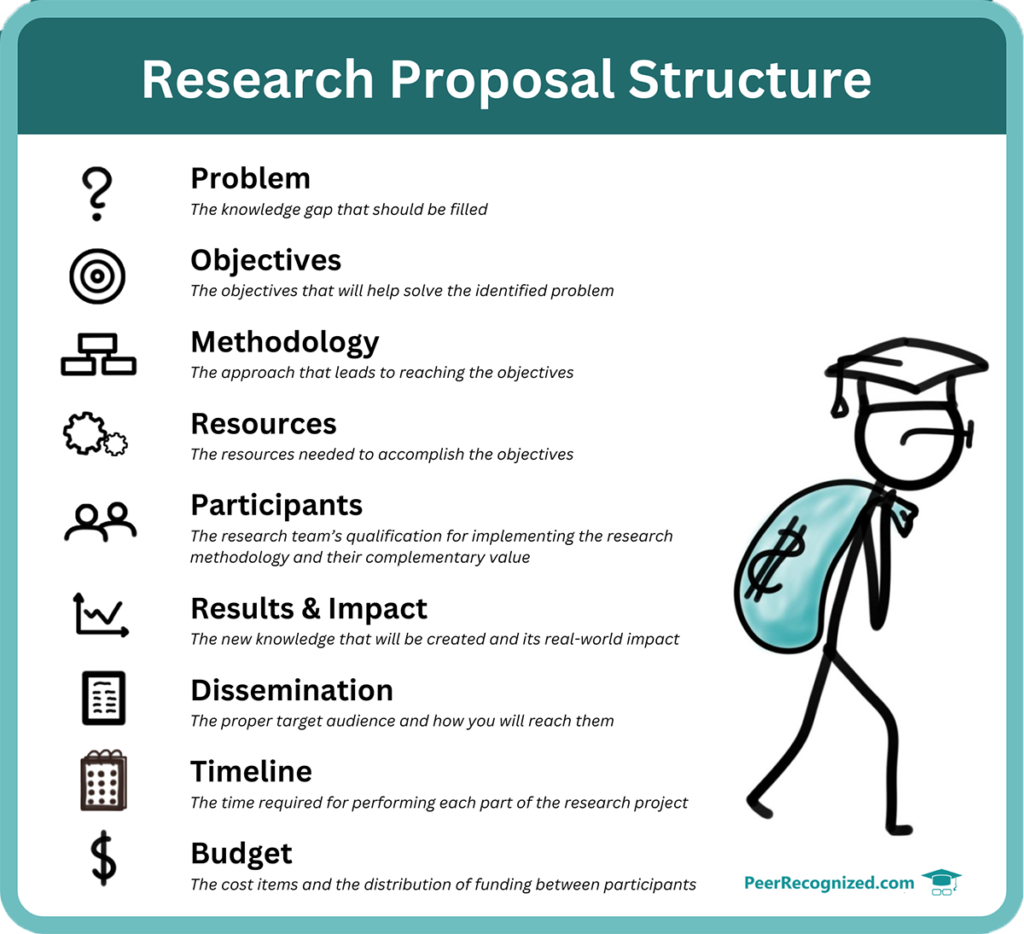
Here is a brief description of what each of the nine proposal sections should hold.
A concise and informative title that captures the essence of the research proposal. Sometimes an abstract is required that briefly summarizes the proposed project.

Clearly define the research problem or gap in knowledge that the study aims to address. Present relevant background information and cite existing literature to support the need for further investigation.

State the specific objectives and research questions that the study seeks to answer. These objectives should be clear, measurable, and aligned with the problem statement.

Methodology
Describe the research design, methodology, and techniques that will be employed to collect and analyze data. Justify your chosen approach and discuss its strengths and limitations.

Outline the resources required for the successful execution of the research project, such as equipment, facilities, software, and access to specific datasets or archives.

Participants
Describe the research team’s qualification for implementing the research methodology and their complementary value

Results and Impact
Describe the expected results, outcomes, and potential impact of the research. Discuss how the findings will contribute to the field and address the research gap identified earlier.

Dissemination
Explain how the research results will be disseminated to the academic community and wider audiences. This may include publications, conference presentations, workshops, data sharing or collaborations with industry partners.

Develop a realistic timeline that outlines the major milestones and activities of the research project. Consider potential challenges or delays and incorporate contingency plans.
Provide a detailed budget estimate, including anticipated expenses for research materials, equipment, participant compensation, travel, and other relevant costs. Justify the budget based on the project’s scope and requirements.
Consider that the above-mentioned proposal headings can be called differently depending on the funder’s requirements. However, you can be sure in one proposal’s section or another each of the mentioned sections will be included. Whenever provided, always use the proposal structure as required by the funding agency.
Research Proposal template download
This research proposal template includes the nine headings that we just discussed. For each heading, a key sentence skeleton is provided to help you to kick-start the proposal writing process.
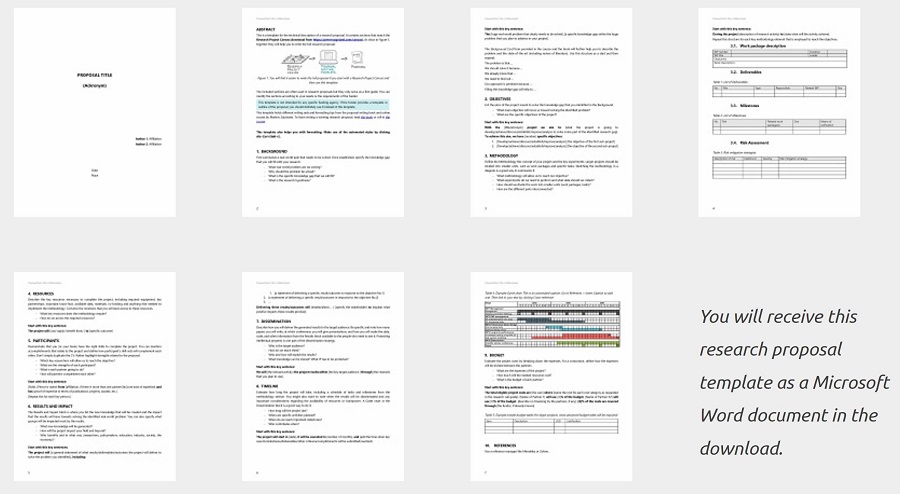
Real-Life Research Proposal Examples
Proposals can vary from field to field so I will provide you with research proposal examples proposals in four main branches of science: social sciences, life sciences, physical sciences, and engineering and technology. For each science field, you will be able to download real-life winning research proposal examples.
To illustrate the principle of writing a scientific proposal while adhering to the nine sections I outlined earlier, for each discipline I will also provide you with a sample hypothetical research proposal. These examples are formulated using the key sentence structure that is included in the download template .
In case the research proposal examples I provide do not hold exactly what you are looking for, use the Open Grants database. It holds approved research proposals from various funding agencies in many countries. When looking for research proposals examples in the database, use the filer to search for specific keywords and organize the results to view proposals that have been funded.
Research Proposals Examples in Social Sciences
Here are real-life research proposal examples of funded projects in social sciences.
| (Cultural Anthropology) | |
Here is an outline of a hypothetical Social Sciences research proposal that is structured using the nine proposal sections we discussed earlier. This proposal example is produced using the key sentence skeleton that you will access in the proposal template .
The Influence of Social Media on Political Participation among Young Adults

Social media platforms have become prominent spaces for political discussions and information sharing. However, the impact of social media on political participation among young adults remains a topic of debate.

With the project, we aim to establish the relationship between social media usage and political engagement among young adults. To achieve this aim, we have three specific objectives:
- Examine the association between social media usage patterns and various forms of political participation, such as voting, attending political rallies, and engaging in political discussions.
- Investigate the role of social media in shaping political attitudes, opinions, and behaviors among young adults.
- Provide evidence-based recommendations for utilizing social media platforms to enhance youth political participation.

During the project, a mixed methods approach, combining quantitative surveys and qualitative interviews will be used to determine the impact of social media use on youth political engagement. In particular, surveys will collect data on social media usage, political participation, and attitudes. Interviews will provide in-depth insights into participants’ experiences and perceptions.

The project will use survey software, transcription tools, and statistical analysis software to statistically evaluate the gathered results. The project will also use project funding for participant compensation.

Principal investigator, Jane Goodrich will lead a multidisciplinary research team comprising social scientists, political scientists, and communication experts with expertise in political science and social media research.

The project will contribute to a better understanding of the influence of social media on political participation among young adults, including:
- inform about the association between social media usage and political participation among youth.
- determine the relationship between social media content and political preferences among youth.
- provide guidelines for enhancing youth engagement in democratic processes through social media use.

We will disseminate the research results within policymakers and NGOs through academic publications in peer-reviewed journals, presentations at relevant conferences, and policy briefs.

The project will start will be completed within two years and for the first two objectives a periodic report will be submitted in months 12 and 18.
The total eligible project costs are 58,800 USD, where 15% covers participant recruitment and compensation, 5% covers survey software licenses, 55% are dedicated for salaries, and 25% are intended for dissemination activities.
Research Proposal Examples in Life Sciences
Here are real-life research project examples in life sciences.
| | |
| | |
| (postdoctoral fellowship) | |
| (National Institutes of Environmental Health Sciences) |
Here is a hypothetical research proposal example in Life Sciences. Just like the previous example, it consists of the nine discussed proposal sections and it is structured using the key sentence skeleton that you will access in the proposal template .
Investigating the Role of Gut Microbiota in Obesity and Metabolic Syndrome (GUT-MET)
Obesity and metabolic syndrome pose significant health challenges worldwide, leading to numerous chronic diseases and increasing healthcare costs. Despite extensive research, the precise mechanisms underlying these conditions remain incompletely understood. A critical knowledge gap exists regarding the role of gut microbiota in the development and progression of obesity and metabolic syndrome.
With the GUT-MET project, we aim to unravel the complex interactions between gut microbiota and obesity/metabolic syndrome. To achieve this aim, we have the following specific objectives:
- Investigate the composition and diversity of gut microbiota in individuals with obesity and metabolic syndrome.
- Determine the functional role of specific gut microbial species and their metabolites in the pathogenesis of obesity and metabolic syndrome.
During the project, we will employ the following key methodologies:
- Perform comprehensive metagenomic and metabolomic analyses to characterize the gut microbiota and associated metabolic pathways.
- Conduct animal studies to investigate the causal relationship between gut microbiota alterations and the development of obesity and metabolic syndrome.
The project will benefit from state-of-the-art laboratory facilities, including advanced sequencing and analytical equipment, as well as access to a well-established cohort of participants with obesity and metabolic syndrome.

Dr. Emma Johnson, a renowned expert in gut microbiota research and Professor of Molecular Biology at the University of PeerRecognized, will lead the project. Dr. Johnson has published extensively in high-impact journals and has received multiple research grants focused on the gut microbiota and metabolic health.
The project will deliver crucial insights into the role of gut microbiota in obesity and metabolic syndrome. Specifically, it will:
- Identify microbial signatures associated with obesity and metabolic syndrome for potential diagnostic and therapeutic applications.
- Uncover key microbial metabolites and pathways implicated in disease development, enabling the development of targeted interventions.
We will actively disseminate the project results within the scientific community, healthcare professionals, and relevant stakeholders through publications in peer-reviewed journals, presentations at international conferences, and engagement with patient advocacy groups.
The project will be executed over a period of 36 months. Key milestones include data collection and analysis, animal studies, manuscript preparation, and knowledge transfer activities.
The total eligible project costs are $1,500,000, with the budget allocated for 55% personnel, 25% laboratory supplies, 5% data analysis, and 15% knowledge dissemination activities as specified in the research call guidelines.
Research Proposals Examples in Natural Sciences
Here are real-life research proposal examples of funded projects in natural sciences.
| (FNU) | |
| (USGS) (Mendenhall Research Fellowship Program) | |
| (Earth Venture Mission – 3 NNH21ZDA002O) |
Here is a Natural Sciences research proposal example that is structured using the same nine sections. I created this proposal example using the key sentence skeleton that you will access in the proposal template .
Assessing the Impact of Climate Change on Biodiversity Dynamics in Fragile Ecosystems (CLIM-BIODIV)
Climate change poses a significant threat to global biodiversity, particularly in fragile ecosystems such as tropical rainforests and coral reefs. Understanding the specific impacts of climate change on biodiversity dynamics within these ecosystems is crucial for effective conservation and management strategies. However, there is a knowledge gap regarding the precise mechanisms through which climate change influences species composition, population dynamics, and ecosystem functioning in these vulnerable habitats.
With the CLIM-BIODIV project, we aim to assess the impact of climate change on biodiversity dynamics in fragile ecosystems. To achieve this aim, we have the following specific objectives:
- Investigate how changes in temperature and precipitation patterns influence species distributions and community composition in tropical rainforests.
- Assess the effects of ocean warming and acidification on coral reef ecosystems, including changes in coral bleaching events, species diversity, and ecosystem resilience.
- Conduct field surveys and employ remote sensing techniques to assess changes in species distributions and community composition in tropical rainforests.
- Utilize experimental approaches and long-term monitoring data to evaluate the response of coral reefs to varying temperature and pH conditions.
The project will benefit from access to field sites in ecologically sensitive regions, advanced remote sensing technology, and collaboration with local conservation organizations to facilitate data collection and knowledge sharing.
Dr. Alexander Chen, an established researcher in climate change and biodiversity conservation, will lead the project. Dr. Chen is a Professor of Ecology at the University of Peer Recognized, with a track record of three Nature publications and successful grant applications exceeding 25 million dollars.
The project will provide valuable insights into the impacts of climate change on biodiversity dynamics in fragile ecosystems. It will:
- Enhance our understanding of how tropical rainforest communities respond to climate change, informing targeted conservation strategies.
- Contribute to the identification of vulnerable coral reef ecosystems and guide management practices for their protection and resilience.
We will disseminate the project results to the scientific community, conservation practitioners, and policymakers through publications in reputable journals, participation in international conferences, and engagement with local communities and relevant stakeholders.
The project will commence on March 1, 2024, and will be implemented over a period of 48 months. Key milestones include data collection and analysis, modeling exercises, stakeholder engagement, and knowledge transfer activities. These are summarized in the Gantt chart.
The total eligible project costs are $2,000,000, with budget allocation for research personnel, fieldwork expenses, laboratory analyses, modeling software, data management, and dissemination activities.
Research Proposal Examples in Engineering and Technology
Here are real-life research proposal examples of funded research projects in the field of science and technology.
| (USGS) (Mendenhall Postdoctoral Research Fellowship) | |
| (ROSES E.7 (Support for Open Source Tools, Frameworks, and Libraries)) |
Here is a hypothetical Engineering and Technology research proposal example that is structured using the same nine proposal sections we discussed earlier. I used the key sentence skeleton available in the proposal template to produce this example.
Developing Sustainable Materials for Energy-Efficient Buildings (SUST-BUILD)
The construction industry is a major contributor to global energy consumption and greenhouse gas emissions. Addressing this issue requires the development of sustainable materials that promote energy efficiency in buildings. However, there is a need for innovative engineering solutions to overcome existing challenges related to the performance, cost-effectiveness, and scalability of such materials.
With the SUST-BUILD project, we aim to develop sustainable materials for energy-efficient buildings. Our specific objectives are as follows:
- Design and optimize novel insulating materials with enhanced thermal properties and reduced environmental impact.
- Develop advanced coatings and surface treatments to improve the energy efficiency and durability of building envelopes.
- Conduct extensive material characterization and simulation studies to guide the design and optimization of insulating materials.
- Utilize advanced coating techniques and perform full-scale testing to evaluate the performance and durability of building envelope treatments.
The project will benefit from access to state-of-the-art laboratory facilities, including material testing equipment, thermal analysis tools, and coating application setups. Collaboration with industry partners will facilitate the translation of research findings into practical applications.
Dr. Maria Rodriguez, an experienced researcher in sustainable materials and building technologies, will lead the project. Dr. Rodriguez holds a position as Associate Professor in the Department of Engineering at Peer Recognized University and has a strong publication record and expertise in the field.
The project will deliver tangible outcomes for energy-efficient buildings. It will:
- Develop sustainable insulating materials with superior thermal performance, contributing to reduced energy consumption and greenhouse gas emissions in buildings.
- Introduce advanced coatings and surface treatments developed from sustainable materials that enhance the durability and energy efficiency of building envelopes, thereby improving long-term building performance.
We will disseminate project results to relevant stakeholders, including industry professionals, architects, and policymakers. This will be accomplished through publications in scientific journals, presentations at conferences and seminars, and engagement with industry associations.

The project will commence on September 1, 2024, and will be implemented over a period of 36 months. Key milestones include material development and optimization, performance testing, prototype fabrication, and knowledge transfer activities. The milestones are summarized in the Gantt chart.
The total eligible project costs are $1,800,000. The budget will cover personnel salaries (60%), materials and equipment (10%), laboratory testing (5%), prototyping (15%), data analysis (5%), and dissemination activities (5%) as specified in the research call guidelines.
Final Tips for Writing an Winning Research Proposal
Come up with a good research idea.
Ideas are the currency of research world. I have prepared a 3 step approach that will help you to come up with a research idea that is worth turning into a proposal. You can download the Research Idea Generation Toolkit in this article.
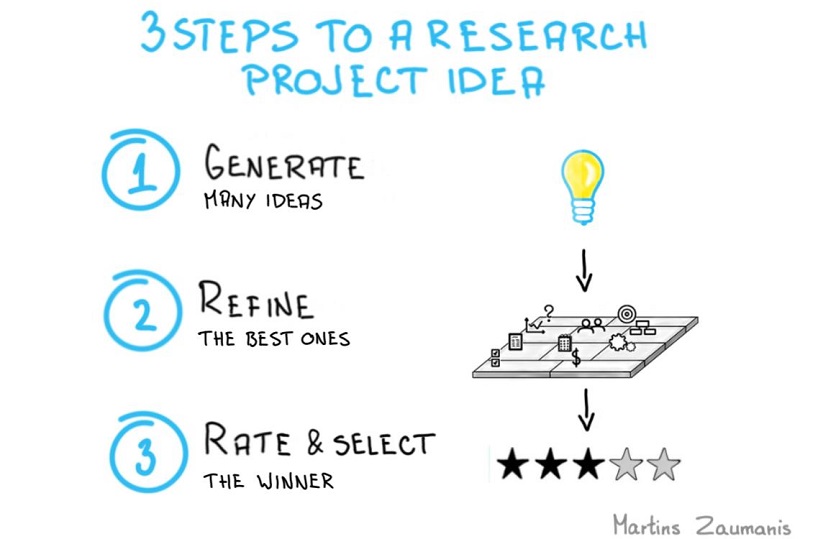
Start with a strong research outline
Before even writing one sentence of the research proposal, I suggest you use the Research Project Canvas . It will help you to first come up with different research ideas and then choose the best one for writing a full research proposal.

Tailor to the requirements of the project funder
Treat the submission guide like a Monk treats the Bible and follow its strict requirements to the last detail. The funder might set requirements for the topic, your experience, employment conditions, host institution, the research team, funding amount, and so forth.
What you would like to do in the research is irrelevant unless it falls within the boundaries defined by the funder.
Make the reviewer’s job of finding flaws in your proposal difficult by ensuring that you have addressed each requirement clearly. If applicable, you can even use a table with requirements versus your approach. This will make your proposed approach absolutely evident for the reviewers.
Before submitting, assess your proposal using the criteria reviewers have to follow.
Conduct thorough background research
Before writing your research proposal, conduct comprehensive background research to familiarize yourself with existing literature, theories, and methodologies related to your topic. This will help you identify research gaps and formulate research questions that address these gaps. You will also establish competence in the eyes of reviewers by citing relevant literature.
Be concise and clear
Define research questions that are specific, measurable, and aligned with the problem statement.
If you think the reviewers might be from a field outside your own, avoid unnecessary jargon or complex language to help them to understand the proposal better.
Be specific in describing the research methodology. For example, include a brief description of the experimental methods you will rely upon, add a summary of the materials that you are going to use, attach samples of questionnaires that you will use, and include any other proof that demonstrates the thoroughness you have put into developing the research plan. Adding a flowchart is a great way to present the methodology.
Create a realistic timeline and budget
Develop a realistic project timeline that includes key milestones and activities, allowing for potential challenges or delays. Similarly, create a detailed budget estimate that covers all anticipated expenses, ensuring that it aligns with the scope and requirements of your research project. Be transparent and justify your budget allocations.
Demonstrate the significance and potential impact of the research
Clearly articulate the significance of your research and its potential impact on the field. Discuss how your findings can contribute to theory development, practical applications, policy-making, or other relevant areas.
Pay attention to formatting and style guidelines
Follow the formatting and style guidelines provided by your institution or funding agency. Pay attention to details such as font size, margins, referencing style, and section headings. Adhering to these guidelines demonstrates professionalism and attention to detail.
Take a break before editing
After preparing the first draft, set it aside for at least a week. Then thoroughly check it for logic and revise, revise, revise. Use the proposal submission guide to review your proposal against the requirements. Remember to use grammar checking tools to check for errors.
Finally, read the proposal out loud. This will help to ensure good readability.
Seek feedback
Share your proposal with mentors, colleagues, or members of your research community to receive constructive feedback and suggestions for improvement. Take these seriously since they provide a third party view of what is written (instead of what you think you have written).
Reviewing good examples is one of the best ways to learn a new skill. I hope that the research proposal examples in this article will be useful for you to get going with writing your own research proposal.
Have fun with the writing process and I hope your project gets approved!
Learning from research proposal examples alone is not enough
The research proposal examples I provided will help you to improve your grant writing skills. But learning from example proposals alone will take you a rather long time to master writing winning proposals.
To write a winning research proposal, you have to know how to add that elusive X-Factor that convinces the reviewers to move your proposal from the category “good” to the category “support”. This includes creating self-explanatory figures, creating a budget, collaborating with co-authors, and presenting a convincing story.
To write a research proposal that maximizes your chances of receiving research funding, read my book “ Write a Winning Research Proposal “.
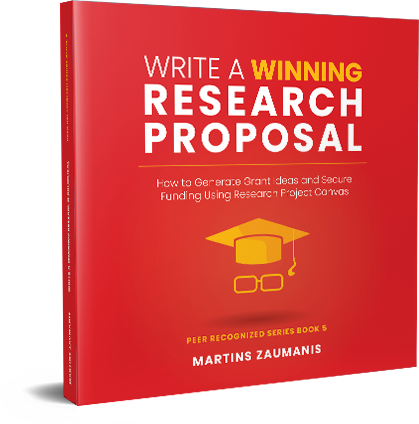
This isn’t just a book. It’s a complete research proposal writing toolkit that includes a project ideation canvas, budget spreadsheet, project rating scorecard, virtual collaboration whiteboard, proposal pitch formula, graphics creation cheat sheet, review checklist and other valuable resources that will help you succeed.

Hey! My name is Martins Zaumanis and I am a materials scientist in Switzerland ( Google Scholar ). As the first person in my family with a PhD, I have first-hand experience of the challenges starting scientists face in academia. With this blog, I want to help young researchers succeed in academia. I call the blog “Peer Recognized”, because peer recognition is what lifts academic careers and pushes science forward.
Besides this blog, I have written the Peer Recognized book series and created the Peer Recognized Academy offering interactive online courses.
Related articles:

One comment
Hi Martins, I’ve recently discovered your content and it is great. I will be implementing much of it into my workflow, as well as using it to teach some graduate courses! I noticed that a materials science-focused proposal could be a very helpful addition.
Leave a Reply Cancel reply
Your email address will not be published. Required fields are marked *
I want to join the Peer Recognized newsletter!
This site uses Akismet to reduce spam. Learn how your comment data is processed .
Privacy Overview
| Cookie | Duration | Description |
|---|---|---|
| cookielawinfo-checkbox-analytics | 11 months | This cookie is set by GDPR Cookie Consent plugin. The cookie is used to store the user consent for the cookies in the category "Analytics". |
| cookielawinfo-checkbox-functional | 11 months | The cookie is set by GDPR cookie consent to record the user consent for the cookies in the category "Functional". |
| cookielawinfo-checkbox-necessary | 11 months | This cookie is set by GDPR Cookie Consent plugin. The cookies is used to store the user consent for the cookies in the category "Necessary". |
| cookielawinfo-checkbox-others | 11 months | This cookie is set by GDPR Cookie Consent plugin. The cookie is used to store the user consent for the cookies in the category "Other. |
| cookielawinfo-checkbox-performance | 11 months | This cookie is set by GDPR Cookie Consent plugin. The cookie is used to store the user consent for the cookies in the category "Performance". |
| viewed_cookie_policy | 11 months | The cookie is set by the GDPR Cookie Consent plugin and is used to store whether or not user has consented to the use of cookies. It does not store any personal data. |
Copyright © 2024 Martins Zaumanis
Contacts: [email protected]
Privacy Policy

How do You Write a Project/Research Proposal for Life Science?
Writing a project/research/PhD proposal for life science, which includes biotechnology, microbiology, genetics and allied subjects, is certainly a different task. It often needs exposure to scientific writing and additional skills regarding the subject.
Students’ PhD endeavor starts by preparing the project or research proposal . It actually shows your interest, knowledge and planning for the project. An inadequately written proposal is immediately rejected by the supervisor.
Frankly speaking, students often prepare their project proposals to impress their guide, instead of showing their knowledge and interest. In addition, some students with knowledge fail too. In either scenario, the reason is clear.
Lack of academic writing experience.
Additionally, when we are talking about life science like pure research subjects, things become even more complicated. One has to demonstrate their writing, research and even experimental skills in the proposal.
Thus, it becomes important for students to understand how to write such a piece of academic write-up before doing anything else. I got my doctorate in one of the life science subjects, then moved to the academic writing field to solve our life science students’ problem of academic writing.
If you are searching this phrase, “ How do you write a project/research proposal for life science?” on the Internet and land on this page, you are on the right article and I am perhaps the right person.
So how can we do that? Let’s find out.
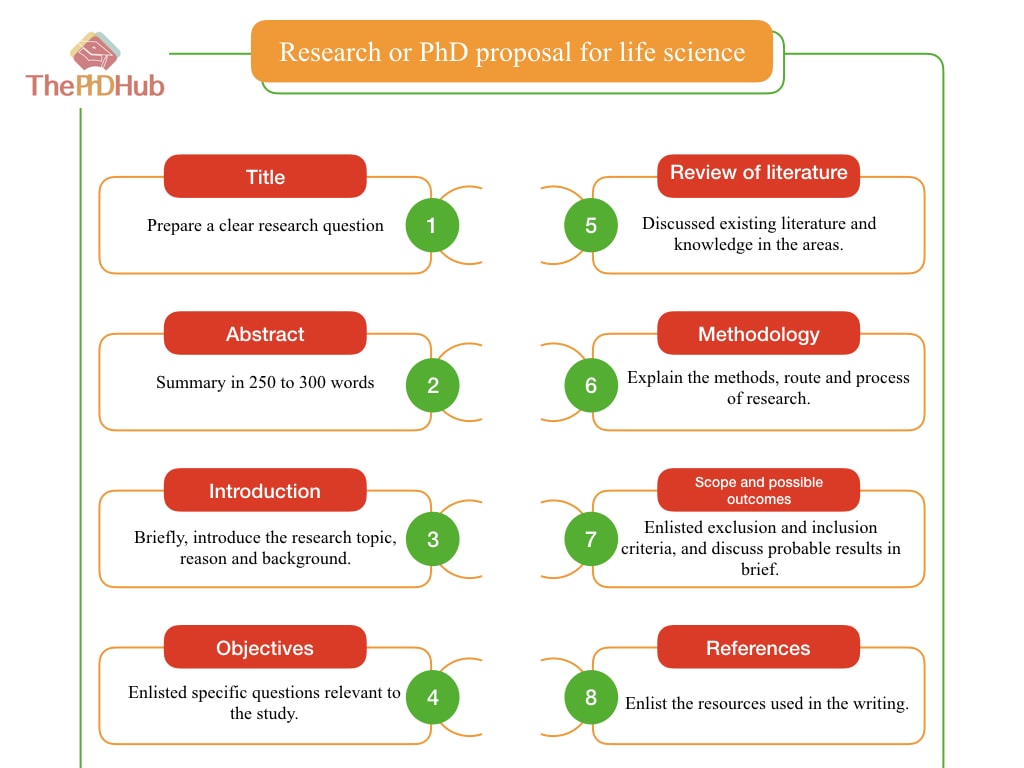
How do you write a project/research proposal for life science?
Every research proposal has some common elements, without which it looks incomplete. Oftentimes, a supervisor checks them first. For instance, it should have a background/ introduction, review of literature, methodology, scope and bibliography sections.
When you blankly initiate your life science project proposal writing, it looks easy, but when it gets rejected or you read things on the internet relevant, it becomes difficult. However, by avoiding common mistakes and following a usual guide, the student can write their own.
At this point, you might be willing to do a PhD, first understand that a life science subject research or project proposal is a different venture than a grant proposal and cover letter. So make it clear that you are writing a research proposal that is the same as a PhD or project proposal.
A life science research proposal is certainly a distinct proposal.
- It should have a comprehensive review of the literature section which discusses all of the major points relevant to the research question.
- The research title should be clear, and concise and must show a clear goal, objective, methods and techniques. I have discussed how to prepare a PhD title in our previous article. You can read it there.
- It should elaboratively explain the materials and methodology section. Wet lab experimentation has been significantly involved in life science research/PhD, so beyond doubts, this section must show how the experimental work would go.
- Also, it must demonstrate sampling, analytical and interpretation methods that help to obtain tentative results thereby achieving objectives.
- It should show the scopes of the study and possible outcomes in terms of societal or real-world importance.
- Lastly, Use correct citation and referencing “in-style.”
Moreover, Also keep in mind what should not be included here. Because after all, everything is covered within 10 to 12 pages (including references).
Things to avoid:
- Give a brief background of the topic. Avoid explaining everything here.
- Review associated research, in brief. Keep in mind that it would justify the research question. Do not discuss separate reviews here.
- Avoid including every possible utility that you are going to use, for example, glassware, plasticware, and instruments, etc. Discuss the SOP, route or road map using which the objectives will be achieved.
- Discuss the method which you have selected, not the technique, in the long run you might have to change the technique. For example,
| We will use students’ P-test and chi-test for our study. A Nested-PCR will be used to discriminate alleles. | We will use common statistical analysis to interpret the results. PCR amplification would be performed to discriminate alleles. |
- Avoid giving a clear statement regarding the results. Instead, enlist possible outcomes. For example,
| The present research work will show the role of BRCA genes in breast cancer. | The present research work will demonstrate if the BRCA genes are linked to breast cancer or not. Such findings will strengthen the present knowledge in the cancer field and help in the prevention of BC. |
- Do not claim anything in the research proposal. For example,
| The present research would surely be in accordance with the previous results… etc | Using the knowledge of the previous research, the objectives of the present research would be discussed. |
Research proposal template for life science:
| Title | Postulate a clear, concise and descriptive title. | 1 |
| Abstract | A 250 to 300 words small summary of the proposal. | Half page |
| Section 1: Introduction | Introduce your research topic, give a thorough background and reason to choose the present topic. | 1.5 |
| Review of literature | Explain where your research fits with previous and existing research in your area. Also, try to discuss why this knowledge would help and strengthen the topic in the future. | 2.5 |
| Objectives | Enlist clear objectives/ research questions of the study. It should clearly support your main research question or title. | 1 |
| Material and methodology | Clearly and concisely explain the methods you will use to solve the question. Also, explain the route, hypothesis and ethical and social problems associated with the study. | 2 |
| Scope of the study | Put simply, explain what to include and what not to do in the stud. Define the parameters, restrictions and expansion of the study. | Half page |
| Possible outcomes | Enlist probably results you and your guide would expect from the present study. | Half |
| References | Enlist all the resources used in the project proposal in style. | 3 |
| Work planning | Explain goals possibly be achieved after months, semesters or years. | 1 |
Research work plan:
I have specifically highlighted the last segment because it is very important and must be included in the research plan, however, students usually avoid it or do not even have an idea about it. Surprisingly, I was not aware of it until I showed it in one of my student’s proposals.
It is amazing, indeed, even I was impressed! It definitely proclaims your interest and preparation for doing research or PhD. It needs a comprehensive explanation to prepare that I think deserves a separate article. Here I am only giving you the template.
| Coursework | ||||||
| Literature review | ||||||
| Preparing PhD title and Developing research proposal | ||||||
| Research work | ||||||
| Progress report-1 (Publishing a review article) | ||||||
| Research work | ||||||
| Progress report-2 (Publishing first research article) | ||||||
| Research work | ||||||
| Progress report-3 | ||||||
| Research work | ||||||
| Progress report-4 (Publishing a second research article) | ||||||
| Research work | ||||||
| Progress report-5 (Publishing the third research article) | ||||||
| Thesis writing and Drafting the thesis | ||||||
| Thesis submission | ||||||
| PhD viva |
Costume PhD writing services:
If you are worried about your research proposal and still lack the concept of how to do it. Leave it to us. I and My team are experienced life science scientists who can do the job for you. Send us an email on [email protected] or [email protected] to get more information.
We can prepare a costume proposal as per your requirements. Remember, we believe in expertise and our’s is in life science. We only accept writing work related to our subject.
Wrapping up:
Life science subjects need attention on so many things. Their focus would be on lab work and hence they face problems in writing such assignments. Sometimes, only bad writing becomes a reason for rejection. This comprehensive guide perhaps benefits you. Still, if you are not sure, contact us, we will help you.
Also, take a tour of our blog, my team has written some amazing articles that certainly help you in your PhD endeavors. If you want to share your PhD experience, please mail us. We will publish your journal to motivate others.

Dr. Tushar Chauhan is a Scientist, Blogger and Scientific-writer. He has completed PhD in Genetics. Dr. Chauhan is a PhD coach and tutor.
Share this:

- Share on Facebook
- Share on Twitter
- Share on Pinterest
- Share on Linkedin
- Share via Email
About The Author

Dr Tushar Chauhan
Related posts.

How to Choose the best Thesis Writing Service in 2022?
1 thought on “how do you write a project/research proposal for life science”.
What’s Going down i’m new to this, I stumbled upon this I’ve found It positively useful and it has aided me out loads. I am hoping to give a contribution & help different users like its helped me. Great job.
Leave a Comment Cancel Reply
Your email address will not be published. Required fields are marked *
Save my name, email, and website in this browser for the next time I comment.
Notify me of follow-up comments by email.
Notify me of new posts by email.
- Research Process
- Manuscript Preparation
- Manuscript Review
- Publication Process
- Publication Recognition
Language Editing Services
- Translation Services

Writing a Scientific Research Project Proposal
- 5 minute read
- 108.3K views
Table of Contents
The importance of a well-written research proposal cannot be underestimated. Your research really is only as good as your proposal. A poorly written, or poorly conceived research proposal will doom even an otherwise worthy project. On the other hand, a well-written, high-quality proposal will increase your chances for success.
In this article, we’ll outline the basics of writing an effective scientific research proposal, including the differences between research proposals, grants and cover letters. We’ll also touch on common mistakes made when submitting research proposals, as well as a simple example or template that you can follow.
What is a scientific research proposal?
The main purpose of a scientific research proposal is to convince your audience that your project is worthwhile, and that you have the expertise and wherewithal to complete it. The elements of an effective research proposal mirror those of the research process itself, which we’ll outline below. Essentially, the research proposal should include enough information for the reader to determine if your proposed study is worth pursuing.
It is not an uncommon misunderstanding to think that a research proposal and a cover letter are the same things. However, they are different. The main difference between a research proposal vs cover letter content is distinct. Whereas the research proposal summarizes the proposal for future research, the cover letter connects you to the research, and how you are the right person to complete the proposed research.
There is also sometimes confusion around a research proposal vs grant application. Whereas a research proposal is a statement of intent, related to answering a research question, a grant application is a specific request for funding to complete the research proposed. Of course, there are elements of overlap between the two documents; it’s the purpose of the document that defines one or the other.
Scientific Research Proposal Format
Although there is no one way to write a scientific research proposal, there are specific guidelines. A lot depends on which journal you’re submitting your research proposal to, so you may need to follow their scientific research proposal template.
In general, however, there are fairly universal sections to every scientific research proposal. These include:
- Title: Make sure the title of your proposal is descriptive and concise. Make it catch and informative at the same time, avoiding dry phrases like, “An investigation…” Your title should pique the interest of the reader.
- Abstract: This is a brief (300-500 words) summary that includes the research question, your rationale for the study, and any applicable hypothesis. You should also include a brief description of your methodology, including procedures, samples, instruments, etc.
- Introduction: The opening paragraph of your research proposal is, perhaps, the most important. Here you want to introduce the research problem in a creative way, and demonstrate your understanding of the need for the research. You want the reader to think that your proposed research is current, important and relevant.
- Background: Include a brief history of the topic and link it to a contemporary context to show its relevance for today. Identify key researchers and institutions also looking at the problem
- Literature Review: This is the section that may take the longest amount of time to assemble. Here you want to synthesize prior research, and place your proposed research into the larger picture of what’s been studied in the past. You want to show your reader that your work is original, and adds to the current knowledge.
- Research Design and Methodology: This section should be very clearly and logically written and organized. You are letting your reader know that you know what you are going to do, and how. The reader should feel confident that you have the skills and knowledge needed to get the project done.
- Preliminary Implications: Here you’ll be outlining how you anticipate your research will extend current knowledge in your field. You might also want to discuss how your findings will impact future research needs.
- Conclusion: This section reinforces the significance and importance of your proposed research, and summarizes the entire proposal.
- References/Citations: Of course, you need to include a full and accurate list of any and all sources you used to write your research proposal.
Common Mistakes in Writing a Scientific Research Project Proposal
Remember, the best research proposal can be rejected if it’s not well written or is ill-conceived. The most common mistakes made include:
- Not providing the proper context for your research question or the problem
- Failing to reference landmark/key studies
- Losing focus of the research question or problem
- Not accurately presenting contributions by other researchers and institutions
- Incompletely developing a persuasive argument for the research that is being proposed
- Misplaced attention on minor points and/or not enough detail on major issues
- Sloppy, low-quality writing without effective logic and flow
- Incorrect or lapses in references and citations, and/or references not in proper format
- The proposal is too long – or too short
Scientific Research Proposal Example
There are countless examples that you can find for successful research proposals. In addition, you can also find examples of unsuccessful research proposals. Search for successful research proposals in your field, and even for your target journal, to get a good idea on what specifically your audience may be looking for.
While there’s no one example that will show you everything you need to know, looking at a few will give you a good idea of what you need to include in your own research proposal. Talk, also, to colleagues in your field, especially if you are a student or a new researcher. We can often learn from the mistakes of others. The more prepared and knowledgeable you are prior to writing your research proposal, the more likely you are to succeed.
One of the top reasons scientific research proposals are rejected is due to poor logic and flow. Check out our Language Editing Services to ensure a great proposal , that’s clear and concise, and properly referenced. Check our video for more information, and get started today.

Research Fraud: Falsification and Fabrication in Research Data

Research Team Structure
You may also like.

Descriptive Research Design and Its Myriad Uses

Five Common Mistakes to Avoid When Writing a Biomedical Research Paper

Making Technical Writing in Environmental Engineering Accessible

To Err is Not Human: The Dangers of AI-assisted Academic Writing

When Data Speak, Listen: Importance of Data Collection and Analysis Methods

Choosing the Right Research Methodology: A Guide for Researchers

Why is data validation important in research?

Writing a good review article
Input your search keywords and press Enter.

- About NuWrite
- Writing Advice
- Engineering & Design
- First-Year Seminars
- Global Health
- Writing in the Humanities
- Lab reports: advice & samples
- Science posters: advice & samples
- Biology honors theses: advice & samples
Sample student biology research proposal (P. Pazos & P. Hirsch 2008)
- Grant / proposal writing
- What committees look for in evaluating a proposal
- Useful web links: citation and style advice from journals, etc.
- Style-advice-science-writing
- Science writing assignments & grading
- SRP-and-SRW
- Social Science Writing
- Writing for Graduate or Professional School
- Writing Advice for International Students
- Faculty-Only Resources
Sample student biology proposal with annotations about content and writing style

- Contact Northwestern University
- Campus Emergency Information
- University Policies
Northwestern University Library | 1970 Campus Drive, Evanston, IL 60208-2300 | Phone: 847.491.7658 | Fax: 847.491.8306 | Email: [email protected]

Science & Quantitative Reasoning Education
Yale undergraduate research, how to write a proposal.
The abstract should summarize your proposal. Include one sentence to introduce the problem you are investigating, why this problem is significant, the hypothesis to be tested, a brief summary of experiments that you wish to conduct and a single concluding sentence. (250 word limit)
Introduction
The introduction discusses the background and significance of the problem you are investigating. Lead the reader from the general to the specific. For example, if you want to write about the role that Brca1 mutations play in breast cancer pathogenesis, talk first about the significance of breast cancer as a disease in the US/world population, then about familial breast cancer as a small subset of breast cancers in general, then about discovery of Brca1 mutations in familial breast cancer, then Brca1’s normal functions in DNA repair, then about how Brca1 mutations result in damaged DNA and onset of familial breast cancer, etc. Definitely include figures with properly labeled text boxes (designated as Figure 1, Figure 2, etc) here to better illustrate your points and help your reader wade through unfamiliar science. (3 pages max)
Formulate a hypothesis that will be tested in your grant proposal. Remember, you are doing hypothesis-driven research so there should be a hypothesis to be tested! The hypothesis should be focused, concise and flow logically from the introduction. For example, your hypothesis could be “I hypothesize that overexpressing wild type Brca1 in Brca1 null tumor cells will prevent metastatic spread in a mouse xenograph model.” Based on your hypothesis, your Specific Aims section should be geared to support it. The hypothesis is stated in one sentence in the proposal.
Specific Aims (listed as Specific Aim 1, Specific Aim 2)
This is where you will want to work with your mentor to craft the experimental portion of your proposal. Propose two original specific aims to test your hypothesis. Don’t propose more than two aims-you will NOT have enough time to do more. In the example presented, Specific Aim 1 might be “To determine the oncogenic potential of Brca1 null cell lines expressing wild type Brca1 cDNA”. Specific aim 2 might be “To determine the metastatic potential of Brca1 null cells that express WT Brca1”. You do not have to go into extensive technical details, just enough for the reader to understand what you propose to do. The best aims yield mechanistic insights-that is, experiments proposed address some mechanisms of biology. A less desirable aim proposes correlative experiments that does not address mechanistically how BRCA1 mutations generate cancer. It is also very important that the two aims are related but NOT interdependent. What this means is that if Aim 1 doesn’t work, Aim 2 is not automatically dead. For example, say you propose in Aim 1 to generate a BRCA1 knockout mouse model, and in Aim 2 you will take tissues from this mouse to do experiments. If knocking out BRCA1 results in early embryonic death, you will never get a mouse that yields tissues for Aim 2. You can include some of your mentor’s data here as “Preliminary data”. Remember to carefully cite all your sources. (4 pages max; 2 pages per Aim)
Potential pitfalls and alternative strategies
This is a very important part of any proposal. This is where you want to discuss the experiments you propose in Aims 1 and 2. Remember, no experiment is perfect. Are there any reasons why experiments you proposed might not work? Why? What will you do to resolve this? What are other possible strategies you might use if your experiments don’t work? If a reviewer spots these deficiencies and you don’t propose methods to correct them, your proposal will not get funded. You will want to work with your mentor to write this section. (1/2 page per Aim)
Cite all references, including unpublished data from your mentor. Last, First, (year), Title, Journal, volume, pages.
*8 page proposal limit (not including References), 1.5 spacing, 12pt Times New Roman font
- View an example of a research proposal submitted for the Yale College First-Year Summer Research Fellowship (PDF).
- View an example of a research proposal submitted for the Yale College Dean’s Research Fellowship and the Rosenfeld Science Scholars Program (PDF) .
- Utility Menu
Undergraduate Science Education at Harvard
A world of exploration. a world of expertise..

Proposal Writing Tips
FELLOWSHIP PROPOSALS
Ideally you should have confirmed a lab position far enough ahead (end of Fall term-January) of the summer fellowship deadlines to allow time to meet with your principal investigator and lab mentor to discuss a project. This will help enormously as you prepare to write the research proposal for your fellowship applications (note, that research proposal requires several drafts before final document can be submitted). The more time you have to prepare drafts of your proposal and get feedback from your mentor, the stronger your application is likely to be. You may find it helpful to set up a timeline for submitting drafts to your mentor to ensure that they will have enough time to read and return them to you with comments before the deadline. DO NOT LEAVE THIS UNTIL THE LAST MINUTE . Your mentor may not have time to review your proposal if you send it to them the day before it is due.
Fellowship proposals have to be tailored to each specific fellowship application. Students are encouraged to read application instructions and include all required information in the specific format that each application requires, including word limit. Two common fellowship proposal guidelines are listed below.
Harvard College Research Program (HCRP): The HCRP application requires a 3-5 page detailed research proposal (see application instructions and make sure to include section headers and each item required for the proposal as well as proposal tips ) and a letter of support from the lab principal investigator.
PRISE (Program for Research in Science and Engineering): PRISE fellows are expected to find their own research positions. However, students may apply to the program before having secured a lab position. PRISE research proposal limit is 500 words. Obviously, students who have not found a lab placement by the application deadline will not be in a position to write a specific project proposal; however, they are expected to submit an essay that broadly outlines their research interests. The selection committee allows some leeway in these instances as long as the essay has some scientific merit and makes a connection between the applicant’s research interests and academic goals. The selection committee expects a more detailed research proposal from students who already have found research positions. Your lab mentor can provide you with background material and work with you on your project proposal. Be sure to phrase the proposal in your own words and not use wording taken directly from lab publications or their web site. You also are required to submit a second essay that describes how you plan to engage in and contribute to the PRISE community.
- Harvard-affiliated Labs
- Research Opportunities and Funding
- Transportation for Researchers
- Undergraduate Research Opportunities (HUROS) Fair
- Undergraduate Research Spotlight
- Resume Template & Proposal Tips
- Lab Citizenship
- Research Ethics and Lab Safety
- Conference Presentation Grants
- Research Advising - Contact Us!
17 Research Proposal Examples

Chris Drew (PhD)
Dr. Chris Drew is the founder of the Helpful Professor. He holds a PhD in education and has published over 20 articles in scholarly journals. He is the former editor of the Journal of Learning Development in Higher Education. [Image Descriptor: Photo of Chris]
Learn about our Editorial Process

A research proposal systematically and transparently outlines a proposed research project.
The purpose of a research proposal is to demonstrate a project’s viability and the researcher’s preparedness to conduct an academic study. It serves as a roadmap for the researcher.
The process holds value both externally (for accountability purposes and often as a requirement for a grant application) and intrinsic value (for helping the researcher to clarify the mechanics, purpose, and potential signficance of the study).
Key sections of a research proposal include: the title, abstract, introduction, literature review, research design and methods, timeline, budget, outcomes and implications, references, and appendix. Each is briefly explained below.
Watch my Guide: How to Write a Research Proposal
Get your Template for Writing your Research Proposal Here (With AI Prompts!)
Research Proposal Sample Structure
Title: The title should present a concise and descriptive statement that clearly conveys the core idea of the research projects. Make it as specific as possible. The reader should immediately be able to grasp the core idea of the intended research project. Often, the title is left too vague and does not help give an understanding of what exactly the study looks at.
Abstract: Abstracts are usually around 250-300 words and provide an overview of what is to follow – including the research problem , objectives, methods, expected outcomes, and significance of the study. Use it as a roadmap and ensure that, if the abstract is the only thing someone reads, they’ll get a good fly-by of what will be discussed in the peice.
Introduction: Introductions are all about contextualization. They often set the background information with a statement of the problem. At the end of the introduction, the reader should understand what the rationale for the study truly is. I like to see the research questions or hypotheses included in the introduction and I like to get a good understanding of what the significance of the research will be. It’s often easiest to write the introduction last
Literature Review: The literature review dives deep into the existing literature on the topic, demosntrating your thorough understanding of the existing literature including themes, strengths, weaknesses, and gaps in the literature. It serves both to demonstrate your knowledge of the field and, to demonstrate how the proposed study will fit alongside the literature on the topic. A good literature review concludes by clearly demonstrating how your research will contribute something new and innovative to the conversation in the literature.
Research Design and Methods: This section needs to clearly demonstrate how the data will be gathered and analyzed in a systematic and academically sound manner. Here, you need to demonstrate that the conclusions of your research will be both valid and reliable. Common points discussed in the research design and methods section include highlighting the research paradigm, methodologies, intended population or sample to be studied, data collection techniques, and data analysis procedures . Toward the end of this section, you are encouraged to also address ethical considerations and limitations of the research process , but also to explain why you chose your research design and how you are mitigating the identified risks and limitations.
Timeline: Provide an outline of the anticipated timeline for the study. Break it down into its various stages (including data collection, data analysis, and report writing). The goal of this section is firstly to establish a reasonable breakdown of steps for you to follow and secondly to demonstrate to the assessors that your project is practicable and feasible.
Budget: Estimate the costs associated with the research project and include evidence for your estimations. Typical costs include staffing costs, equipment, travel, and data collection tools. When applying for a scholarship, the budget should demonstrate that you are being responsible with your expensive and that your funding application is reasonable.
Expected Outcomes and Implications: A discussion of the anticipated findings or results of the research, as well as the potential contributions to the existing knowledge, theory, or practice in the field. This section should also address the potential impact of the research on relevant stakeholders and any broader implications for policy or practice.
References: A complete list of all the sources cited in the research proposal, formatted according to the required citation style. This demonstrates the researcher’s familiarity with the relevant literature and ensures proper attribution of ideas and information.
Appendices (if applicable): Any additional materials, such as questionnaires, interview guides, or consent forms, that provide further information or support for the research proposal. These materials should be included as appendices at the end of the document.
Research Proposal Examples
Research proposals often extend anywhere between 2,000 and 15,000 words in length. The following snippets are samples designed to briefly demonstrate what might be discussed in each section.
1. Education Studies Research Proposals
See some real sample pieces:
- Assessment of the perceptions of teachers towards a new grading system
- Does ICT use in secondary classrooms help or hinder student learning?
- Digital technologies in focus project
- Urban Middle School Teachers’ Experiences of the Implementation of
- Restorative Justice Practices
- Experiences of students of color in service learning
Consider this hypothetical education research proposal:
The Impact of Game-Based Learning on Student Engagement and Academic Performance in Middle School Mathematics
Abstract: The proposed study will explore multiplayer game-based learning techniques in middle school mathematics curricula and their effects on student engagement. The study aims to contribute to the current literature on game-based learning by examining the effects of multiplayer gaming in learning.
Introduction: Digital game-based learning has long been shunned within mathematics education for fears that it may distract students or lower the academic integrity of the classrooms. However, there is emerging evidence that digital games in math have emerging benefits not only for engagement but also academic skill development. Contributing to this discourse, this study seeks to explore the potential benefits of multiplayer digital game-based learning by examining its impact on middle school students’ engagement and academic performance in a mathematics class.
Literature Review: The literature review has identified gaps in the current knowledge, namely, while game-based learning has been extensively explored, the role of multiplayer games in supporting learning has not been studied.
Research Design and Methods: This study will employ a mixed-methods research design based upon action research in the classroom. A quasi-experimental pre-test/post-test control group design will first be used to compare the academic performance and engagement of middle school students exposed to game-based learning techniques with those in a control group receiving instruction without the aid of technology. Students will also be observed and interviewed in regard to the effect of communication and collaboration during gameplay on their learning.
Timeline: The study will take place across the second term of the school year with a pre-test taking place on the first day of the term and the post-test taking place on Wednesday in Week 10.
Budget: The key budgetary requirements will be the technologies required, including the subscription cost for the identified games and computers.
Expected Outcomes and Implications: It is expected that the findings will contribute to the current literature on game-based learning and inform educational practices, providing educators and policymakers with insights into how to better support student achievement in mathematics.
2. Psychology Research Proposals
See some real examples:
- A situational analysis of shared leadership in a self-managing team
- The effect of musical preference on running performance
- Relationship between self-esteem and disordered eating amongst adolescent females
Consider this hypothetical psychology research proposal:
The Effects of Mindfulness-Based Interventions on Stress Reduction in College Students
Abstract: This research proposal examines the impact of mindfulness-based interventions on stress reduction among college students, using a pre-test/post-test experimental design with both quantitative and qualitative data collection methods .
Introduction: College students face heightened stress levels during exam weeks. This can affect both mental health and test performance. This study explores the potential benefits of mindfulness-based interventions such as meditation as a way to mediate stress levels in the weeks leading up to exam time.
Literature Review: Existing research on mindfulness-based meditation has shown the ability for mindfulness to increase metacognition, decrease anxiety levels, and decrease stress. Existing literature has looked at workplace, high school and general college-level applications. This study will contribute to the corpus of literature by exploring the effects of mindfulness directly in the context of exam weeks.
Research Design and Methods: Participants ( n= 234 ) will be randomly assigned to either an experimental group, receiving 5 days per week of 10-minute mindfulness-based interventions, or a control group, receiving no intervention. Data will be collected through self-report questionnaires, measuring stress levels, semi-structured interviews exploring participants’ experiences, and students’ test scores.
Timeline: The study will begin three weeks before the students’ exam week and conclude after each student’s final exam. Data collection will occur at the beginning (pre-test of self-reported stress levels) and end (post-test) of the three weeks.
Expected Outcomes and Implications: The study aims to provide evidence supporting the effectiveness of mindfulness-based interventions in reducing stress among college students in the lead up to exams, with potential implications for mental health support and stress management programs on college campuses.
3. Sociology Research Proposals
- Understanding emerging social movements: A case study of ‘Jersey in Transition’
- The interaction of health, education and employment in Western China
- Can we preserve lower-income affordable neighbourhoods in the face of rising costs?
Consider this hypothetical sociology research proposal:
The Impact of Social Media Usage on Interpersonal Relationships among Young Adults
Abstract: This research proposal investigates the effects of social media usage on interpersonal relationships among young adults, using a longitudinal mixed-methods approach with ongoing semi-structured interviews to collect qualitative data.
Introduction: Social media platforms have become a key medium for the development of interpersonal relationships, particularly for young adults. This study examines the potential positive and negative effects of social media usage on young adults’ relationships and development over time.
Literature Review: A preliminary review of relevant literature has demonstrated that social media usage is central to development of a personal identity and relationships with others with similar subcultural interests. However, it has also been accompanied by data on mental health deline and deteriorating off-screen relationships. The literature is to-date lacking important longitudinal data on these topics.
Research Design and Methods: Participants ( n = 454 ) will be young adults aged 18-24. Ongoing self-report surveys will assess participants’ social media usage, relationship satisfaction, and communication patterns. A subset of participants will be selected for longitudinal in-depth interviews starting at age 18 and continuing for 5 years.
Timeline: The study will be conducted over a period of five years, including recruitment, data collection, analysis, and report writing.
Expected Outcomes and Implications: This study aims to provide insights into the complex relationship between social media usage and interpersonal relationships among young adults, potentially informing social policies and mental health support related to social media use.
4. Nursing Research Proposals
- Does Orthopaedic Pre-assessment clinic prepare the patient for admission to hospital?
- Nurses’ perceptions and experiences of providing psychological care to burns patients
- Registered psychiatric nurse’s practice with mentally ill parents and their children
Consider this hypothetical nursing research proposal:
The Influence of Nurse-Patient Communication on Patient Satisfaction and Health Outcomes following Emergency Cesarians
Abstract: This research will examines the impact of effective nurse-patient communication on patient satisfaction and health outcomes for women following c-sections, utilizing a mixed-methods approach with patient surveys and semi-structured interviews.
Introduction: It has long been known that effective communication between nurses and patients is crucial for quality care. However, additional complications arise following emergency c-sections due to the interaction between new mother’s changing roles and recovery from surgery.
Literature Review: A review of the literature demonstrates the importance of nurse-patient communication, its impact on patient satisfaction, and potential links to health outcomes. However, communication between nurses and new mothers is less examined, and the specific experiences of those who have given birth via emergency c-section are to date unexamined.
Research Design and Methods: Participants will be patients in a hospital setting who have recently had an emergency c-section. A self-report survey will assess their satisfaction with nurse-patient communication and perceived health outcomes. A subset of participants will be selected for in-depth interviews to explore their experiences and perceptions of the communication with their nurses.
Timeline: The study will be conducted over a period of six months, including rolling recruitment, data collection, analysis, and report writing within the hospital.
Expected Outcomes and Implications: This study aims to provide evidence for the significance of nurse-patient communication in supporting new mothers who have had an emergency c-section. Recommendations will be presented for supporting nurses and midwives in improving outcomes for new mothers who had complications during birth.
5. Social Work Research Proposals
- Experiences of negotiating employment and caring responsibilities of fathers post-divorce
- Exploring kinship care in the north region of British Columbia
Consider this hypothetical social work research proposal:
The Role of a Family-Centered Intervention in Preventing Homelessness Among At-Risk Youthin a working-class town in Northern England
Abstract: This research proposal investigates the effectiveness of a family-centered intervention provided by a local council area in preventing homelessness among at-risk youth. This case study will use a mixed-methods approach with program evaluation data and semi-structured interviews to collect quantitative and qualitative data .
Introduction: Homelessness among youth remains a significant social issue. This study aims to assess the effectiveness of family-centered interventions in addressing this problem and identify factors that contribute to successful prevention strategies.
Literature Review: A review of the literature has demonstrated several key factors contributing to youth homelessness including lack of parental support, lack of social support, and low levels of family involvement. It also demonstrates the important role of family-centered interventions in addressing this issue. Drawing on current evidence, this study explores the effectiveness of one such intervention in preventing homelessness among at-risk youth in a working-class town in Northern England.
Research Design and Methods: The study will evaluate a new family-centered intervention program targeting at-risk youth and their families. Quantitative data on program outcomes, including housing stability and family functioning, will be collected through program records and evaluation reports. Semi-structured interviews with program staff, participants, and relevant stakeholders will provide qualitative insights into the factors contributing to program success or failure.
Timeline: The study will be conducted over a period of six months, including recruitment, data collection, analysis, and report writing.
Budget: Expenses include access to program evaluation data, interview materials, data analysis software, and any related travel costs for in-person interviews.
Expected Outcomes and Implications: This study aims to provide evidence for the effectiveness of family-centered interventions in preventing youth homelessness, potentially informing the expansion of or necessary changes to social work practices in Northern England.
Research Proposal Template
Get your Detailed Template for Writing your Research Proposal Here (With AI Prompts!)
This is a template for a 2500-word research proposal. You may find it difficult to squeeze everything into this wordcount, but it’s a common wordcount for Honors and MA-level dissertations.
| Section | Checklist |
|---|---|
| Title | – Ensure the single-sentence title clearly states the study’s focus |
| Abstract (Words: 200) | – Briefly describe the research topicSummarize the research problem or question – Outline the research design and methods – Mention the expected outcomes and implications |
| Introduction (Words: 300) | – Introduce the research topic and its significance – Clearly state the research problem or question – Explain the purpose and objectives of the study – Provide a brief overview of |
| Literature Review (Words: 800) | – Gather the existing literature into themes and ket ideas – the themes and key ideas in the literature – Identify gaps or inconsistencies in the literature – Explain how the current study will contribute to the literature |
| Research Design and Methods (Words; 800) | – Describe the research paradigm (generally: positivism and interpretivism) – Describe the research design (e.g., qualitative, quantitative, or mixed-methods) – Explain the data collection methods (e.g., surveys, interviews, observations) – Detail the sampling strategy and target population – Outline the data analysis techniques (e.g., statistical analysis, thematic analysis) – Outline your validity and reliability procedures – Outline your intended ethics procedures – Explain the study design’s limitations and justify your decisions |
| Timeline (Single page table) | – Provide an overview of the research timeline – Break down the study into stages with specific timeframes (e.g., data collection, analysis, report writing) – Include any relevant deadlines or milestones |
| Budget (200 words) | – Estimate the costs associated with the research project – Detail specific expenses (e.g., materials, participant incentives, travel costs) – Include any necessary justifications for the budget items – Mention any funding sources or grant applications |
| Expected Outcomes and Implications (200 words) | – Summarize the anticipated findings or results of the study – Discuss the potential implications of the findings for theory, practice, or policy – Describe any possible limitations of the study |
Your research proposal is where you really get going with your study. I’d strongly recommend working closely with your teacher in developing a research proposal that’s consistent with the requirements and culture of your institution, as in my experience it varies considerably. The above template is from my own courses that walk students through research proposals in a British School of Education.

- Chris Drew (PhD) https://helpfulprofessor.com/author/chris-drew-phd/ 101 Class Group Name Ideas (for School Students)
- Chris Drew (PhD) https://helpfulprofessor.com/author/chris-drew-phd/ 19 Top Cognitive Psychology Theories (Explained)
- Chris Drew (PhD) https://helpfulprofessor.com/author/chris-drew-phd/ 119 Bloom’s Taxonomy Examples
- Chris Drew (PhD) https://helpfulprofessor.com/author/chris-drew-phd/ All 6 Levels of Understanding (on Bloom’s Taxonomy)
8 thoughts on “17 Research Proposal Examples”
Very excellent research proposals
very helpful
Very helpful
Dear Sir, I need some help to write an educational research proposal. Thank you.

Hi Levi, use the site search bar to ask a question and I’ll likely have a guide already written for your specific question. Thanks for reading!
very good research proposal
Thank you so much sir! ❤️
Very helpful 👌
Leave a Comment Cancel Reply
Your email address will not be published. Required fields are marked *
- Privacy Policy

Home » How To Write A Research Proposal – Step-by-Step [Template]
How To Write A Research Proposal – Step-by-Step [Template]
Table of Contents

How To Write a Research Proposal
Writing a Research proposal involves several steps to ensure a well-structured and comprehensive document. Here is an explanation of each step:
1. Title and Abstract
- Choose a concise and descriptive title that reflects the essence of your research.
- Write an abstract summarizing your research question, objectives, methodology, and expected outcomes. It should provide a brief overview of your proposal.
2. Introduction:
- Provide an introduction to your research topic, highlighting its significance and relevance.
- Clearly state the research problem or question you aim to address.
- Discuss the background and context of the study, including previous research in the field.
3. Research Objectives
- Outline the specific objectives or aims of your research. These objectives should be clear, achievable, and aligned with the research problem.
4. Literature Review:
- Conduct a comprehensive review of relevant literature and studies related to your research topic.
- Summarize key findings, identify gaps, and highlight how your research will contribute to the existing knowledge.
5. Methodology:
- Describe the research design and methodology you plan to employ to address your research objectives.
- Explain the data collection methods, instruments, and analysis techniques you will use.
- Justify why the chosen methods are appropriate and suitable for your research.
6. Timeline:
- Create a timeline or schedule that outlines the major milestones and activities of your research project.
- Break down the research process into smaller tasks and estimate the time required for each task.
7. Resources:
- Identify the resources needed for your research, such as access to specific databases, equipment, or funding.
- Explain how you will acquire or utilize these resources to carry out your research effectively.
8. Ethical Considerations:
- Discuss any ethical issues that may arise during your research and explain how you plan to address them.
- If your research involves human subjects, explain how you will ensure their informed consent and privacy.
9. Expected Outcomes and Significance:
- Clearly state the expected outcomes or results of your research.
- Highlight the potential impact and significance of your research in advancing knowledge or addressing practical issues.
10. References:
- Provide a list of all the references cited in your proposal, following a consistent citation style (e.g., APA, MLA).
11. Appendices:
- Include any additional supporting materials, such as survey questionnaires, interview guides, or data analysis plans.
Research Proposal Format
The format of a research proposal may vary depending on the specific requirements of the institution or funding agency. However, the following is a commonly used format for a research proposal:
1. Title Page:
- Include the title of your research proposal, your name, your affiliation or institution, and the date.
2. Abstract:
- Provide a brief summary of your research proposal, highlighting the research problem, objectives, methodology, and expected outcomes.
3. Introduction:
- Introduce the research topic and provide background information.
- State the research problem or question you aim to address.
- Explain the significance and relevance of the research.
- Review relevant literature and studies related to your research topic.
- Summarize key findings and identify gaps in the existing knowledge.
- Explain how your research will contribute to filling those gaps.
5. Research Objectives:
- Clearly state the specific objectives or aims of your research.
- Ensure that the objectives are clear, focused, and aligned with the research problem.
6. Methodology:
- Describe the research design and methodology you plan to use.
- Explain the data collection methods, instruments, and analysis techniques.
- Justify why the chosen methods are appropriate for your research.
7. Timeline:
8. Resources:
- Explain how you will acquire or utilize these resources effectively.
9. Ethical Considerations:
- If applicable, explain how you will ensure informed consent and protect the privacy of research participants.
10. Expected Outcomes and Significance:
11. References:
12. Appendices:
Research Proposal Template
Here’s a template for a research proposal:
1. Introduction:
2. Literature Review:
3. Research Objectives:
4. Methodology:
5. Timeline:
6. Resources:
7. Ethical Considerations:
8. Expected Outcomes and Significance:
9. References:
10. Appendices:
Research Proposal Sample
Title: The Impact of Online Education on Student Learning Outcomes: A Comparative Study
1. Introduction
Online education has gained significant prominence in recent years, especially due to the COVID-19 pandemic. This research proposal aims to investigate the impact of online education on student learning outcomes by comparing them with traditional face-to-face instruction. The study will explore various aspects of online education, such as instructional methods, student engagement, and academic performance, to provide insights into the effectiveness of online learning.
2. Objectives
The main objectives of this research are as follows:
- To compare student learning outcomes between online and traditional face-to-face education.
- To examine the factors influencing student engagement in online learning environments.
- To assess the effectiveness of different instructional methods employed in online education.
- To identify challenges and opportunities associated with online education and suggest recommendations for improvement.
3. Methodology
3.1 Study Design
This research will utilize a mixed-methods approach to gather both quantitative and qualitative data. The study will include the following components:
3.2 Participants
The research will involve undergraduate students from two universities, one offering online education and the other providing face-to-face instruction. A total of 500 students (250 from each university) will be selected randomly to participate in the study.
3.3 Data Collection
The research will employ the following data collection methods:
- Quantitative: Pre- and post-assessments will be conducted to measure students’ learning outcomes. Data on student demographics and academic performance will also be collected from university records.
- Qualitative: Focus group discussions and individual interviews will be conducted with students to gather their perceptions and experiences regarding online education.
3.4 Data Analysis
Quantitative data will be analyzed using statistical software, employing descriptive statistics, t-tests, and regression analysis. Qualitative data will be transcribed, coded, and analyzed thematically to identify recurring patterns and themes.
4. Ethical Considerations
The study will adhere to ethical guidelines, ensuring the privacy and confidentiality of participants. Informed consent will be obtained, and participants will have the right to withdraw from the study at any time.
5. Significance and Expected Outcomes
This research will contribute to the existing literature by providing empirical evidence on the impact of online education on student learning outcomes. The findings will help educational institutions and policymakers make informed decisions about incorporating online learning methods and improving the quality of online education. Moreover, the study will identify potential challenges and opportunities related to online education and offer recommendations for enhancing student engagement and overall learning outcomes.
6. Timeline
The proposed research will be conducted over a period of 12 months, including data collection, analysis, and report writing.
The estimated budget for this research includes expenses related to data collection, software licenses, participant compensation, and research assistance. A detailed budget breakdown will be provided in the final research plan.
8. Conclusion
This research proposal aims to investigate the impact of online education on student learning outcomes through a comparative study with traditional face-to-face instruction. By exploring various dimensions of online education, this research will provide valuable insights into the effectiveness and challenges associated with online learning. The findings will contribute to the ongoing discourse on educational practices and help shape future strategies for maximizing student learning outcomes in online education settings.
About the author
Muhammad Hassan
Researcher, Academic Writer, Web developer
You may also like


How To Write A Business Proposal – Step-by-Step...

Proposal – Types, Examples, and Writing Guide

Grant Proposal – Example, Template and Guide

How To Write A Grant Proposal – Step-by-Step...

Business Proposal – Templates, Examples and Guide

How to choose an Appropriate Method for Research?
- Postgraduate
Research degrees
- Examples of Research proposals
- Find a course
- Accessibility
Examples of research proposals
How to write your research proposal, with examples of good proposals.
Research proposals
Your research proposal is a key part of your application. It tells us about the question you want to answer through your research. It is a chance for you to show your knowledge of the subject area and tell us about the methods you want to use.
We use your research proposal to match you with a supervisor or team of supervisors.
In your proposal, please tell us if you have an interest in the work of a specific academic at York St John. You can get in touch with this academic to discuss your proposal. You can also speak to one of our Research Leads. There is a list of our Research Leads on the Apply page.
When you write your proposal you need to:
- Highlight how it is original or significant
- Explain how it will develop or challenge current knowledge of your subject
- Identify the importance of your research
- Show why you are the right person to do this research
- Research Proposal Example 1 (DOC, 49kB)
- Research Proposal Example 2 (DOC, 0.9MB)
- Research Proposal Example 3 (DOC, 55.5kB)
- Research Proposal Example 4 (DOC, 49.5kB)
Subject specific guidance
- Writing a Humanities PhD Proposal (PDF, 0.1MB)
- Writing a Creative Writing PhD Proposal (PDF, 0.1MB)
- About the University
- Our culture and values
- Academic schools
- Academic dates
- Press office
Our wider work
- Business support
- Work in the community
- Donate or support
Connect with us
York St John University
Lord Mayor’s Walk
01904 624 624
York St John London Campus
6th Floor Export Building
1 Clove Crescent
01904 876 944

- Policies and documents
- Module documents
- Programme specifications
- Quality gateway
- Admissions documents
- Access and Participation Plan
- Freedom of information
- Accessibility statement
- Modern slavery and human trafficking statement
© York St John University 2024
Colour Picker
Lorem ipsum dolor sit amet, consectetur adipiscing elit, sed do eiusmod tempor incididunt ut labore et dolore magna aliqua. Dui id ornare arcu odio.
Felis bibendum ut tristique et egestas quis ipsum. Et netus et malesuada fames ac turpis egestas. Faucibus pulvinar elementum integer enim neque volutpat ac. Hac habitasse platea dictumst vestibulum rhoncus.
Nec ullamcorper sit amet risus nullam eget felis eget. Eget felis eget nunc lobortis mattis aliquam faucibus purus.
Have a language expert improve your writing
Run a free plagiarism check in 10 minutes, automatically generate references for free.
- Knowledge Base
- Research process
- How to Write a Research Proposal | Examples & Templates
How to Write a Research Proposal | Examples & Templates
Published on 30 October 2022 by Shona McCombes and Tegan George. Revised on 13 June 2023.

A research proposal describes what you will investigate, why it’s important, and how you will conduct your research.
The format of a research proposal varies between fields, but most proposals will contain at least these elements:
Introduction
Literature review.
- Research design
Reference list
While the sections may vary, the overall objective is always the same. A research proposal serves as a blueprint and guide for your research plan, helping you get organised and feel confident in the path forward you choose to take.
Table of contents
Research proposal purpose, research proposal examples, research design and methods, contribution to knowledge, research schedule, frequently asked questions.
Academics often have to write research proposals to get funding for their projects. As a student, you might have to write a research proposal as part of a grad school application , or prior to starting your thesis or dissertation .
In addition to helping you figure out what your research can look like, a proposal can also serve to demonstrate why your project is worth pursuing to a funder, educational institution, or supervisor.
| Show your reader why your project is interesting, original, and important. | |
| Demonstrate your comfort and familiarity with your field. Show that you understand the current state of research on your topic. | |
| Make a case for your . Demonstrate that you have carefully thought about the data, tools, and procedures necessary to conduct your research. | |
| Confirm that your project is feasible within the timeline of your program or funding deadline. |
Research proposal length
The length of a research proposal can vary quite a bit. A bachelor’s or master’s thesis proposal can be just a few pages, while proposals for PhD dissertations or research funding are usually much longer and more detailed. Your supervisor can help you determine the best length for your work.
One trick to get started is to think of your proposal’s structure as a shorter version of your thesis or dissertation , only without the results , conclusion and discussion sections.
Download our research proposal template
Prevent plagiarism, run a free check.
Writing a research proposal can be quite challenging, but a good starting point could be to look at some examples. We’ve included a few for you below.
- Example research proposal #1: ‘A Conceptual Framework for Scheduling Constraint Management’
- Example research proposal #2: ‘ Medical Students as Mediators of Change in Tobacco Use’
Like your dissertation or thesis, the proposal will usually have a title page that includes:
- The proposed title of your project
- Your supervisor’s name
- Your institution and department
The first part of your proposal is the initial pitch for your project. Make sure it succinctly explains what you want to do and why.
Your introduction should:
- Introduce your topic
- Give necessary background and context
- Outline your problem statement and research questions
To guide your introduction , include information about:
- Who could have an interest in the topic (e.g., scientists, policymakers)
- How much is already known about the topic
- What is missing from this current knowledge
- What new insights your research will contribute
- Why you believe this research is worth doing
As you get started, it’s important to demonstrate that you’re familiar with the most important research on your topic. A strong literature review shows your reader that your project has a solid foundation in existing knowledge or theory. It also shows that you’re not simply repeating what other people have already done or said, but rather using existing research as a jumping-off point for your own.
In this section, share exactly how your project will contribute to ongoing conversations in the field by:
- Comparing and contrasting the main theories, methods, and debates
- Examining the strengths and weaknesses of different approaches
- Explaining how will you build on, challenge, or synthesise prior scholarship
Following the literature review, restate your main objectives . This brings the focus back to your own project. Next, your research design or methodology section will describe your overall approach, and the practical steps you will take to answer your research questions.
| ? or ? , , or research design? | |
| , )? ? | |
| , , , )? | |
| ? |
To finish your proposal on a strong note, explore the potential implications of your research for your field. Emphasise again what you aim to contribute and why it matters.
For example, your results might have implications for:
- Improving best practices
- Informing policymaking decisions
- Strengthening a theory or model
- Challenging popular or scientific beliefs
- Creating a basis for future research
Last but not least, your research proposal must include correct citations for every source you have used, compiled in a reference list . To create citations quickly and easily, you can use our free APA citation generator .
Some institutions or funders require a detailed timeline of the project, asking you to forecast what you will do at each stage and how long it may take. While not always required, be sure to check the requirements of your project.
Here’s an example schedule to help you get started. You can also download a template at the button below.
Download our research schedule template
| Research phase | Objectives | Deadline |
|---|---|---|
| 1. Background research and literature review | 20th January | |
| 2. Research design planning | and data analysis methods | 13th February |
| 3. Data collection and preparation | with selected participants and code interviews | 24th March |
| 4. Data analysis | of interview transcripts | 22nd April |
| 5. Writing | 17th June | |
| 6. Revision | final work | 28th July |
If you are applying for research funding, chances are you will have to include a detailed budget. This shows your estimates of how much each part of your project will cost.
Make sure to check what type of costs the funding body will agree to cover. For each item, include:
- Cost : exactly how much money do you need?
- Justification : why is this cost necessary to complete the research?
- Source : how did you calculate the amount?
To determine your budget, think about:
- Travel costs : do you need to go somewhere to collect your data? How will you get there, and how much time will you need? What will you do there (e.g., interviews, archival research)?
- Materials : do you need access to any tools or technologies?
- Help : do you need to hire any research assistants for the project? What will they do, and how much will you pay them?
Once you’ve decided on your research objectives , you need to explain them in your paper, at the end of your problem statement.
Keep your research objectives clear and concise, and use appropriate verbs to accurately convey the work that you will carry out for each one.
I will compare …
A research aim is a broad statement indicating the general purpose of your research project. It should appear in your introduction at the end of your problem statement , before your research objectives.
Research objectives are more specific than your research aim. They indicate the specific ways you’ll address the overarching aim.
A PhD, which is short for philosophiae doctor (doctor of philosophy in Latin), is the highest university degree that can be obtained. In a PhD, students spend 3–5 years writing a dissertation , which aims to make a significant, original contribution to current knowledge.
A PhD is intended to prepare students for a career as a researcher, whether that be in academia, the public sector, or the private sector.
A master’s is a 1- or 2-year graduate degree that can prepare you for a variety of careers.
All master’s involve graduate-level coursework. Some are research-intensive and intend to prepare students for further study in a PhD; these usually require their students to write a master’s thesis . Others focus on professional training for a specific career.
Critical thinking refers to the ability to evaluate information and to be aware of biases or assumptions, including your own.
Like information literacy , it involves evaluating arguments, identifying and solving problems in an objective and systematic way, and clearly communicating your ideas.
Cite this Scribbr article
If you want to cite this source, you can copy and paste the citation or click the ‘Cite this Scribbr article’ button to automatically add the citation to our free Reference Generator.
McCombes, S. & George, T. (2023, June 13). How to Write a Research Proposal | Examples & Templates. Scribbr. Retrieved 1 July 2024, from https://www.scribbr.co.uk/the-research-process/research-proposal-explained/
Is this article helpful?
Shona McCombes
Other students also liked, what is a research methodology | steps & tips, what is a literature review | guide, template, & examples, how to write a results section | tips & examples.
What’s Included: Research Proposal Template
Our free dissertation/thesis proposal template covers the core essential ingredients for a strong research proposal. It includes clear explanations of what you need to address in each section, as well as straightforward examples and links to further resources.
The research proposal template covers the following core elements:
- Introduction & background (including the research problem)
- Literature review
- Research design / methodology
- Project plan , resource requirements and risk management
The cleanly-formatted Google Doc can be downloaded as a fully editable MS Word Document (DOCX format), so you can use it as-is or convert it to LaTeX.
PS – if you’d like a high-level template for the entire thesis, you can we’ve got that too .
Research Proposal Template FAQS
What types of research proposals can this template be used for.
The proposal template follows the standard format for academic research projects, which means it will be suitable for the vast majority of dissertations and theses (especially those within the sciences), whether they are qualitative or quantitative in terms of design.
Keep in mind that the exact requirements for the introduction chapter/section will vary between universities and degree programs. These are typically minor, but it’s always a good idea to double-check your university’s requirements before you finalise your structure.
Is this template for an undergrad, Master or PhD-level proposal?
This template can be used for a research project at any level of study. Doctoral-level projects typically require the research proposal to be more extensive/comprehensive, but the structure will typically remain the same.
How long should my research proposal be?
The length of a research proposal varies by institution and subject, but as a ballpark, it’s usually between 1,500 and 3,000 words.
To be safe, it’s best to check with your university if they have any preferences or requirements in terms of minimum and maximum word count for the research propsal.
How detailed should the methodology of the proposal be?
You don’t need to go into the fine details of your methodology, but this section should be detailed enough to demonstrate that your research approach is feasible and will address your research questions effectively. Be sure to include your intended methods for data collection and analysis.
Can I include preliminary data or pilot study results in my proposal?
Generally, yes. This can strengthen your proposal by demonstrating the feasibility of your research. However, make sure that your pilot study is approved by your university before collecting any data.
Can I share this template with my friends/colleagues?
Yes, you’re welcome to share this template in its original format (no editing allowed). If you want to post about it on your blog or social media, we kindly request that you reference this page as your source.
What format is the template (DOC, PDF, PPT, etc.)?
The research proposal template is provided as a Google Doc. You can download it in MS Word format or make a copy to your Google Drive. You’re also welcome to convert it to whatever format works best for you, such as LaTeX or PDF.
Do you have templates for the other chapters?
Yes, we do. We are constantly developing our collection of free resources to help students complete their dissertations and theses. You can view all of our template resources here .
Can Grad Coach help me with my dissertation/thesis?
Yes, you’re welcome to get in touch with us to discuss our private coaching services .
Further Resources: Proposal Writing
The template provides step-by-step guidance for each section of your research proposal, but if you’d like to learn more about how to write up a high-quality research proposal, check out the rest of our free proposal-related resources:
- Research Proposal 101
- Examples of research proposals
- How To Find A Research Topic
- How To Find A Research Gap
- Developing Your Golden Thread
- How To Write A Research Proposal
- 8 Common Proposal Writing Mistakes
You can also visit the Grad Coach blog for more proposal-related resources.

If you’d prefer 1-on-1 support with your research proposal, have a look at our private coaching service , where we hold your hand through the research process, step by step.
Newly Launched - AI Presentation Maker

Researched by Consultants from Top-Tier Management Companies

Powerpoint Templates
Icon Bundle
Kpi Dashboard
Professional
Business Plans
Swot Analysis
Gantt Chart
Business Proposal
Marketing Plan
Project Management
Business Case
Business Model
Cyber Security
Business PPT
Digital Marketing
Digital Transformation
Human Resources
Product Management
Artificial Intelligence
Company Profile
Acknowledgement PPT
PPT Presentation
Reports Brochures
One Page Pitch
Interview PPT
All Categories
Top 10 Science Project Proposal Templates With Samples and Examples
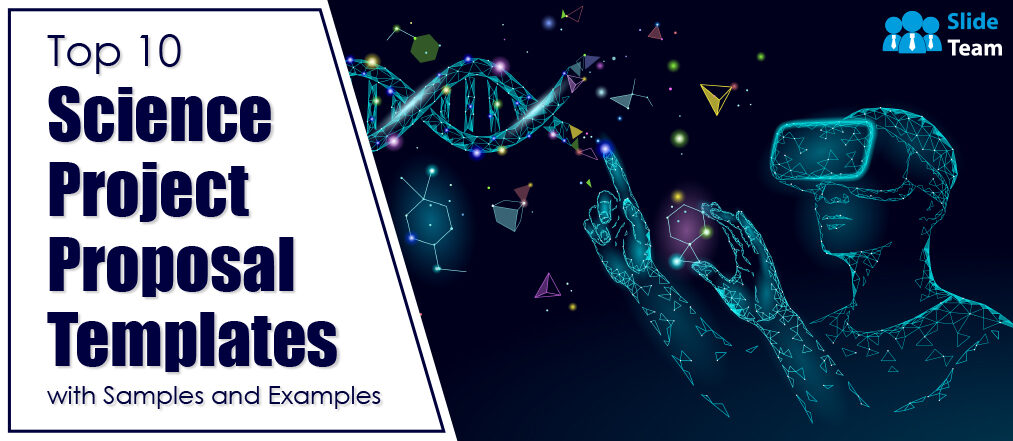
Nawsheen Muzamil
Everything that happens around us is science. To understand it better, humans have been investing in research and development projects for ages.
From the discovery of vaccines to save us against deadly diseases to employing data science as a way of interpreting data, scientific research projects have always rewarded us a race. For instance, a latest discovery brought the world’s attention to the lost continent of Zealandia.
In another event, as the world celebrated the Nobel Laureates for this year, we also acknowledged the steadfastness of Katalin Kariko in her discovery of the covid-19 vaccine. Despite her four times demotion, her struggle of 20 years in securing funds for her research ultimately bore us a panacea. In fueling such scientific endeavors, f inancing has always been an endeavor that tests human resolve, persistence, and tenacity.
Whether it is for a school project or a billion-dollar company’s R&D program, attracting funds is a carefully guided process. To acquire these much-needed investments, special attention is paid to science project proposals that act as formal documents to pitch fund request. While institutional projects may not require surplus funds, it’s the permission to explore, use institution’s resources, and conduct experiments, if needed, that requires proposals. A science project proposal is the only accepted form of acquiring such permits. Similarly, in case of projects that require colossal funding, such proposals help researchers and scientists onboard investors.
If you are seeking sponosrs to fuel your projects or want your organizational experts to undertake scientific research of clients, download this content-ready selection of science project proposal templates from SlideTeam. Showcase your fervor for conducting research by demonstrating experience and expertise in the field as you pitch for investment requests using our science project proposal templates.
Even better, each of these templates is 100% editable and customizable. You get structure, a starting point and the capability to mold the presentation to unique audience profile.
Just like the Nobel Medicine Prize winner, Kariko, stand your ground in having your science projects financed till you achieve your goal. Have these science project proposal templates in your library to do that. Download now.
Template 1: Data Science Project Proposal Report Sample Example Document
Here’s a comprehensive complete deck to pitch your expertise in designing software that will help your client analyze customer patterns. This data science project proposal PPT Template will convince your client in developing the best solution to evaluate its customer base and offer useful products and services that also drive sales. Share the systematic plan of action in developing such software that also includes testing and updating. Use this template to help your clients understand the expenses involved and finally create an agreement upon their acceptance to this editable science project proposal deck presentation. Download now.
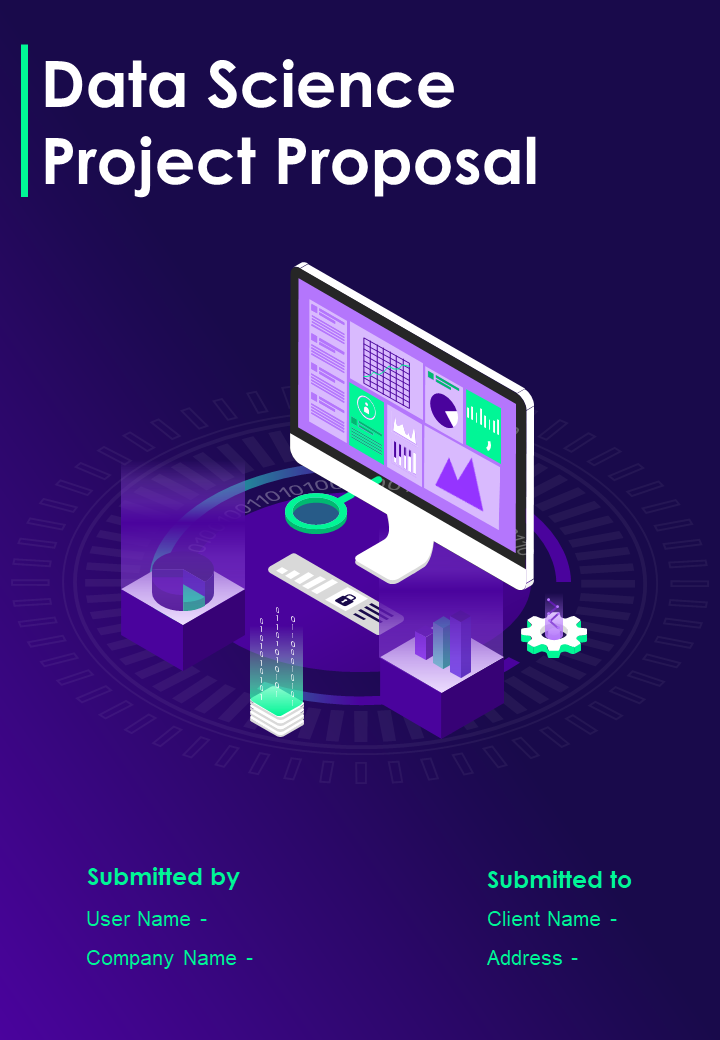
Download this template
Template 2: Computer Science Project Proposal Report Sample Example Document
If your company’s expertise lies in developing web applications, here's a proposal template to pitch your business. State your understanding of the client’s requirement in developing the app for customizing nutrition plans with this computer science project proposal template. Share the scope of work, plan of action, and investments required in taking this project to completion. After you have established trust with testimonials and your company details, you can move ahead and lay the terms of the contract. Lastly, this proposal template allows you to affix signatures of the parties concerned. Download this complete deck now.
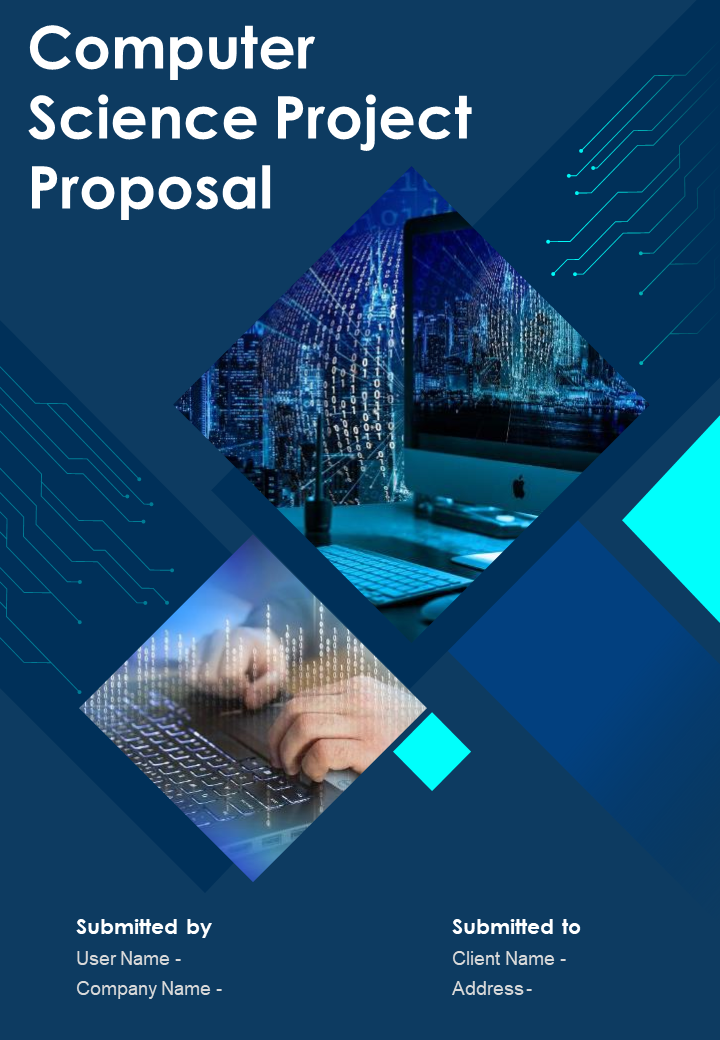
Template 3: Life Science Examination Project Proposal Example Document Report
Here’s your go-to slide to pitch your proposal to seek investment for a life-science project. Establish the aim of the research you’re about to conduct and its scope. Share a glimpse of the team leading the project and the exact make and quality of the equipment you are employing for the same. Then proceed onto the investment part and share a general idea of where resources and money will be spent in the project. Finally, record the affirmation and acceptance of the terms and conditions of the proposal via a designated, already-prepared statement of work and contract template and onboard another powerful investor to back your project. Download now.
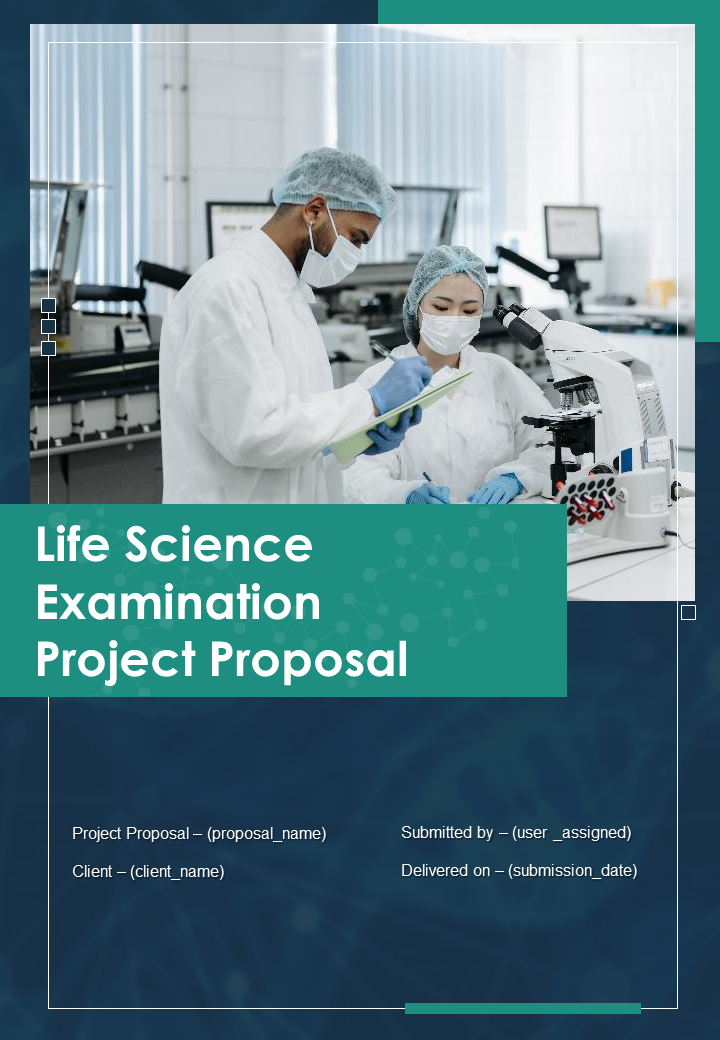
Template 4: One-Page Science Research Proposal Example Presentation Report
Invite investors to fund your science research program with this concise one-page proposal template. Share the proposal abstract research design as shown. Talk about the research in terms of the problem it aims to address, the purpose of the study, and its significance in the scientific community. Finally, specify the research instrumentation, and the modes of collecting data. Lastly, you can also share a broad framework of the project plan according to which the project would run. Share all such valuable insights about your science research with a download of this PPT Template now.
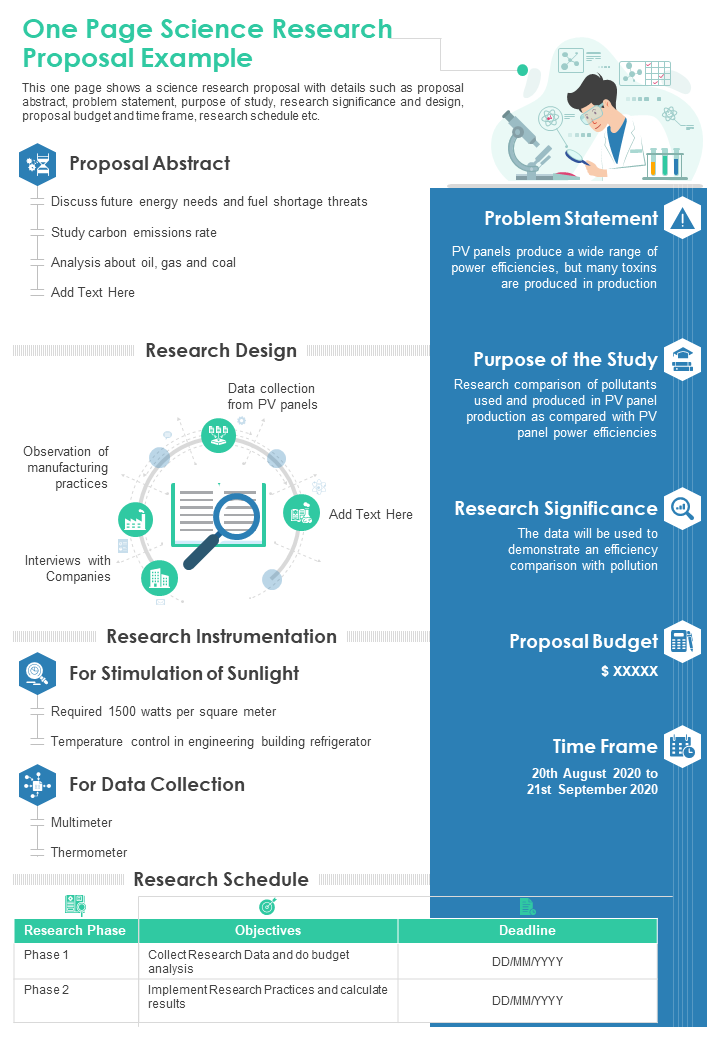
Template 5: Project Context for Data Science Template
In this science project proposal template, discuss your understanding of the client's assignment and offer a customized solution. Share aspects of the project that you will target and propose an appropriate solution to each problem. This PPT Layout will also act as a guide to your clients in understanding what all will be targeted in the project and a basic understanding of the roadmap and timeline can also be assumed. This template is a crucial part of a full-fledged complete deck that you can download from the link below.
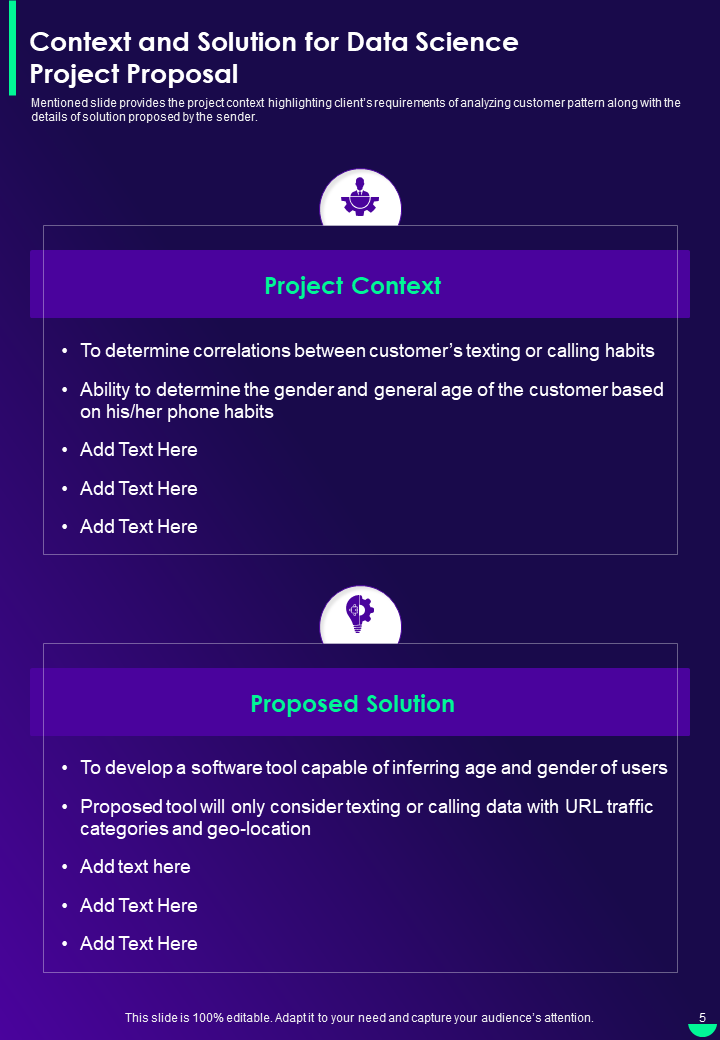
Template 6: Science project Timeline
Share the anticipated timeline for your science project with this pre-designed PPT Template. With this PPT Chart, summarize the tasks of the project and align and schedule a better project. Specify the task durations, and experts assigned to monitor these. Plan out the tasks and the personnel responsible for overseeing these. To download the template along with its complete deck, click on the link below.
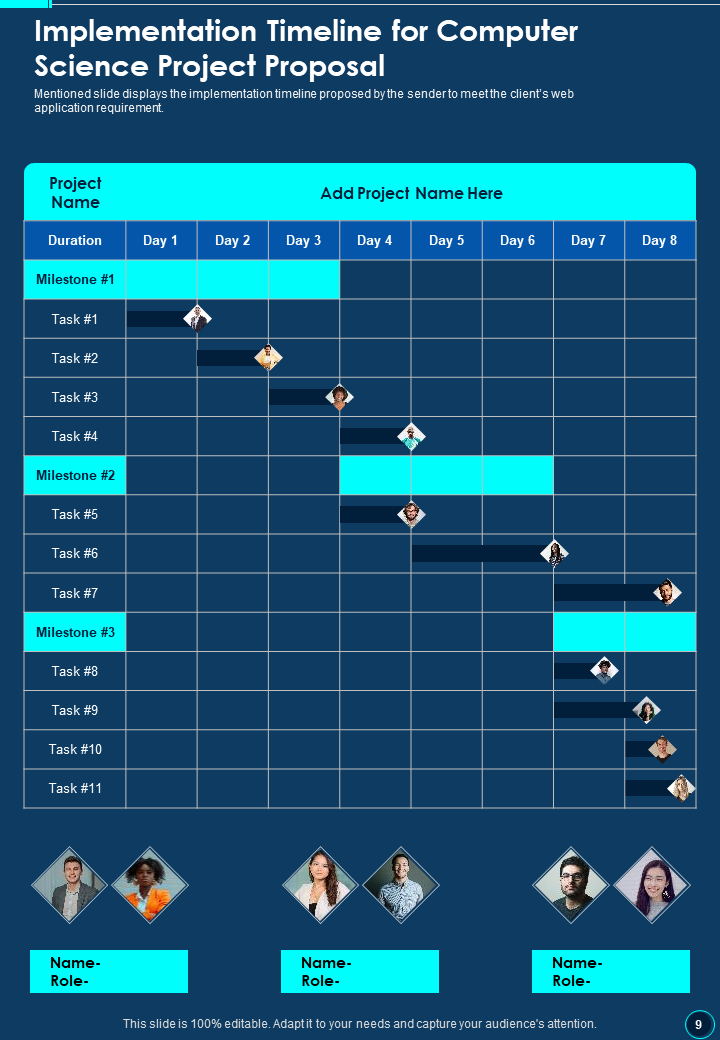
Template 7: Company Overview with Vision and Goals
Share your company’s vision and mission statement that will reinforce your proposal with this PPT Design. By adding this PPT Template to your science project proposal, you can point out your laser-sharp focus in achieving goals and directing the company vision. Use this presentation template to depict important parameters of your achievements like client ratings, number of experienced professionals, client affiliations with Fortune 500 companies, etc. To download the full complete deck of which this template is a part of, click on the link below.
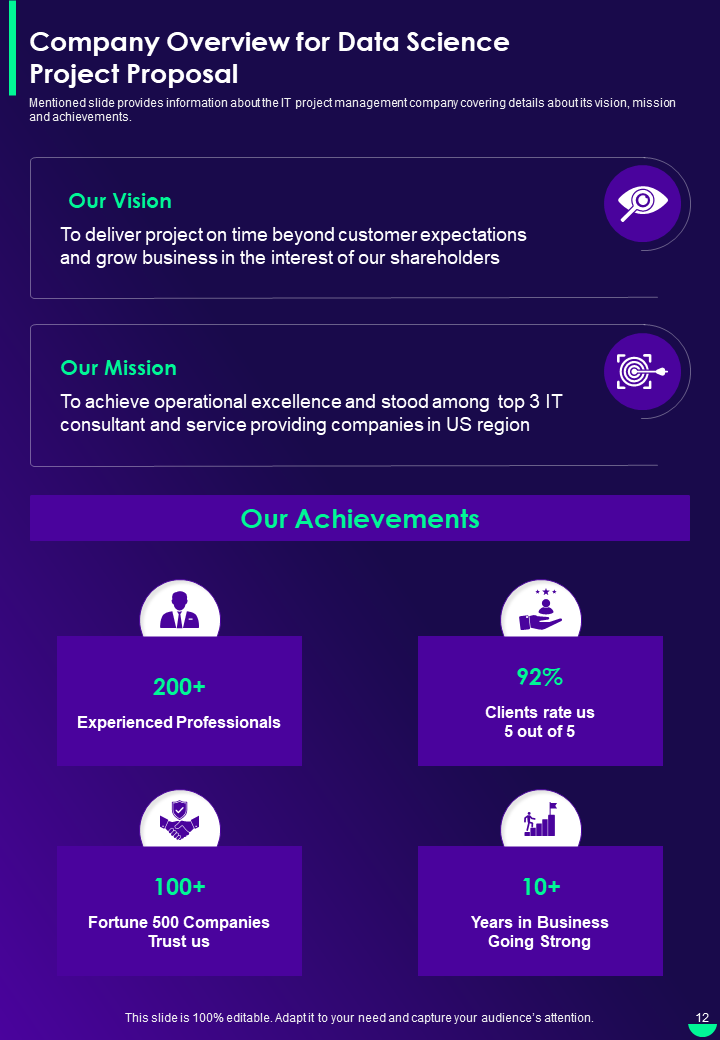
Template 8: Budget
Elaborate the budget estimate for your science project with this content-ready PPT Layout. Share the distribution of the funds for aspects of the project like diagnosis, documentation, technology, manpower, etc and also mention the total running summary of expenses involved. This template is a crucial part of a full-fledged complete deck that you can download from the link below.
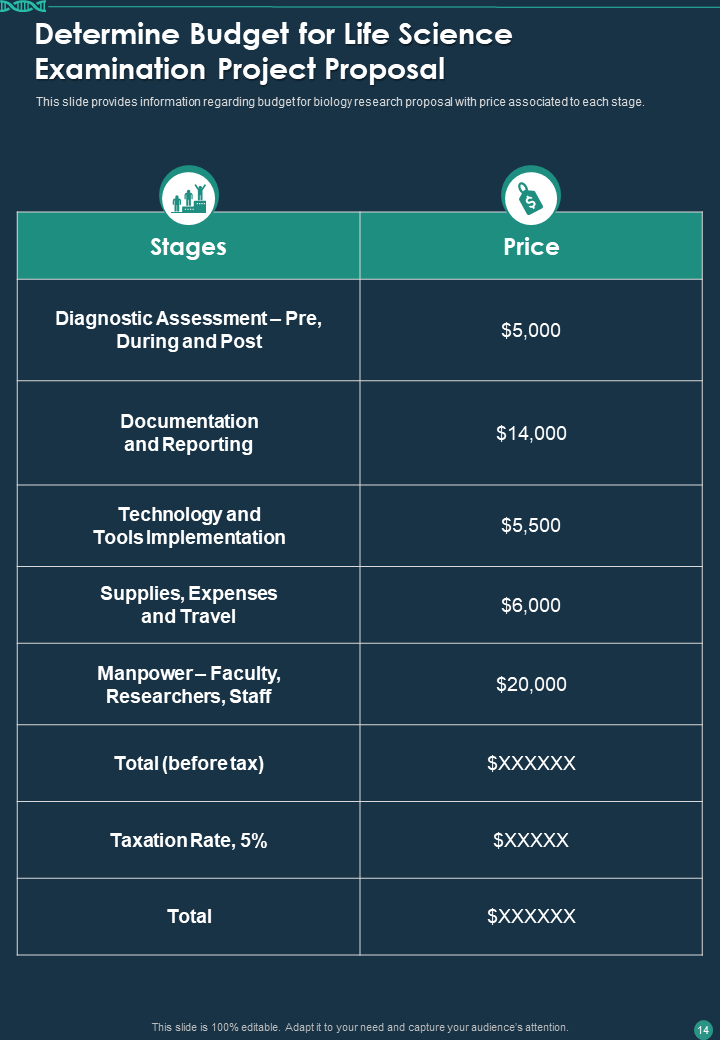
Template 9: Products and Technologies Used
It always helps to showcase the sophisticated tools and techniques you are using in your science project. With this pre-designed template, you can showcase the elaborate list of products and technologies employed in achieving desired results. By pointing out the well-known tools and techniques, you can also justify the investments and add to the transparency of your science project proposal. Download the complete deck of which this template is an important part from the link below.
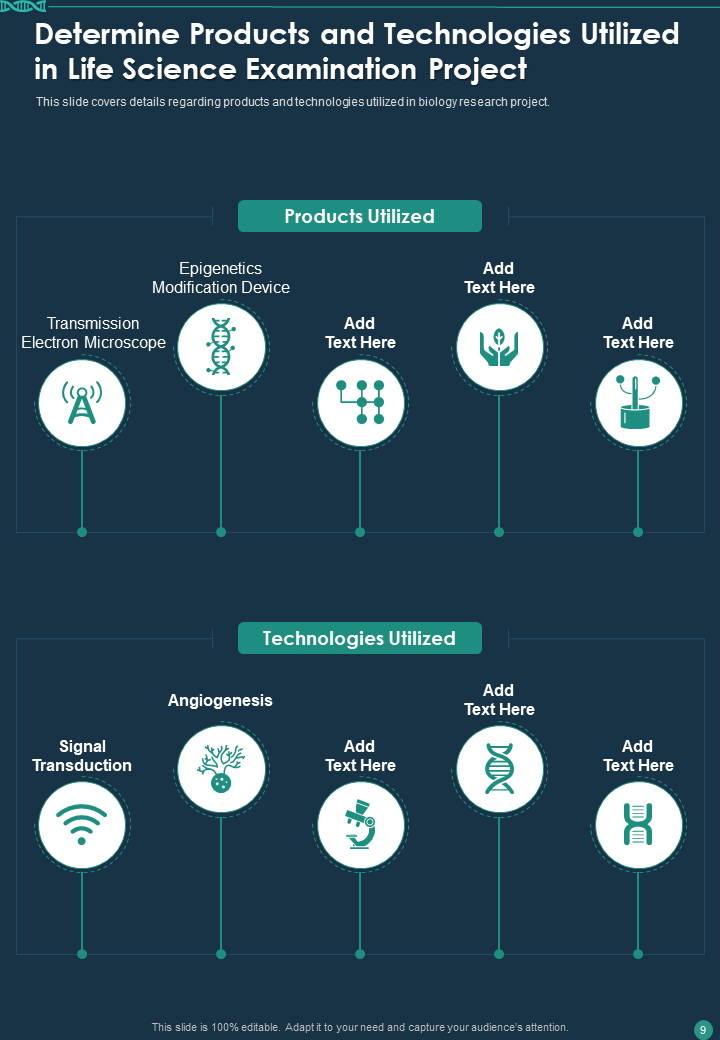
Template 10: Statement of Work and Contract
This presentation template summarizes all terms and conditions associated with the proposal. Intimate your investors about the proposal bindings and their obligations. Discuss the validity of this contract, terms of payment, confidentiality, and condition for cancellation of this contract within this content-ready PPT Layout. Download the complete PPT Presentation from the link below.
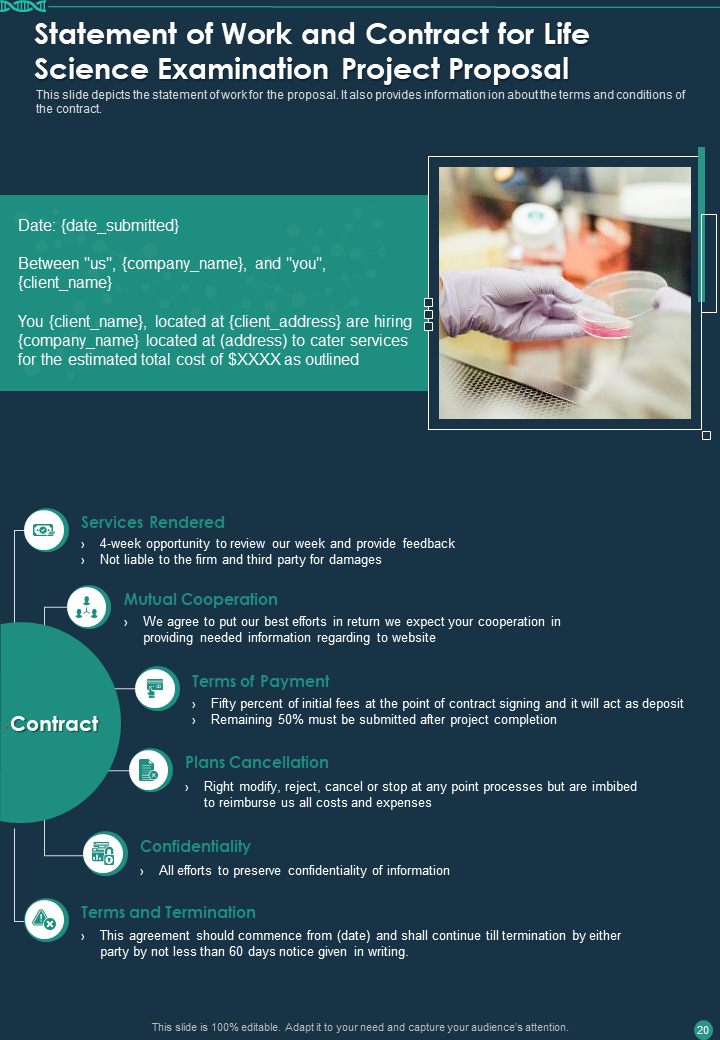
Unlock Innovations and Discoveries
Claim these expert-presentations to prepare client-winning proposals. Your next big innovation requires the boost of these science project proposal templates. Download now.
PS: Share the design for the anticipated flow of your research project with these roadmap templates, designed to mark milestones and also show the way. Explore the guide featuring the 10 best designs here.
Related posts:
- Top 10 Documentary Proposal Templates With Examples and Samples
- Top 5 Project Issue Tracker Templates With Samples and Examples
- Top 10 Employee Evaluation Scorecard Templates With Examples and Samples
- Top 7 Communication Flow Chart Templates With Samples and Examples
Liked this blog? Please recommend us

Must-Have Wheel of Life Templates with Samples and Examples
![research proposal example life science Top 10 Product Specification Templates With Samples and Examples [Free PDF Attached]](https://www.slideteam.net/wp/wp-content/uploads/2022/11/product-specification-templates-1013x441.jpg)
Top 10 Product Specification Templates With Samples and Examples [Free PDF Attached]

Top 10 Rent Contract Template Designs to Sign an Agreement Between Tenant and Landlord
![research proposal example life science 15+ Best Templates to Present an Innovative Waste Management Plan [Free PDF Attached]](https://www.slideteam.net/wp/wp-content/uploads/2022/02/15Best-Waste-Management-Plan-Templates_1-1013x441.png)
15+ Best Templates to Present an Innovative Waste Management Plan [Free PDF Attached]
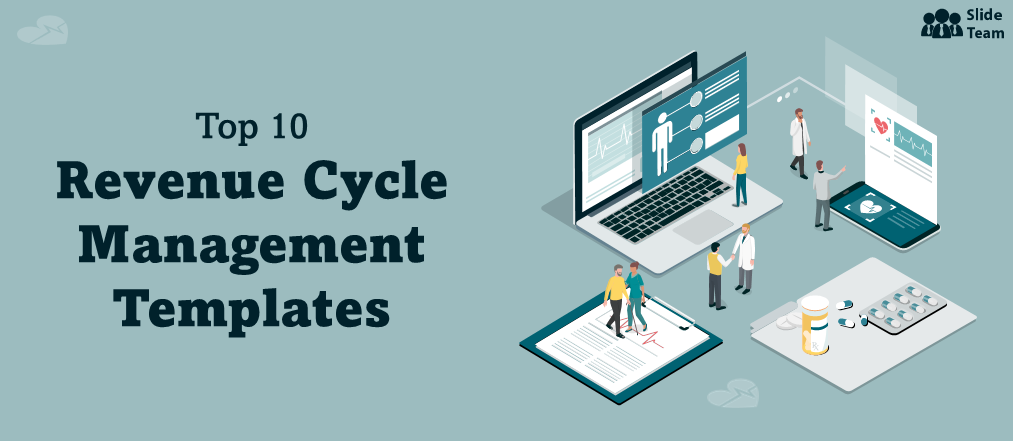
Top 10 Revenue Cycle Management Templates to Give a Boost to the Healthcare Sector
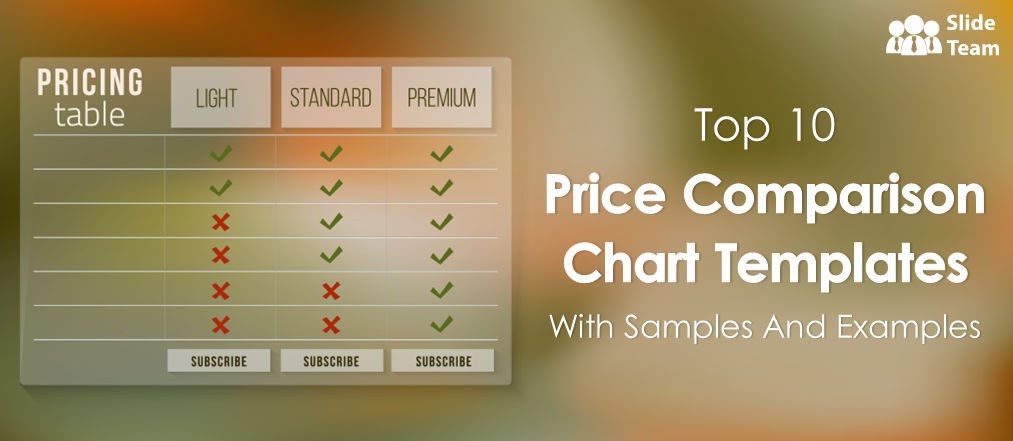
Top 10 Price Comparison Chart Templates with Examples and Samples
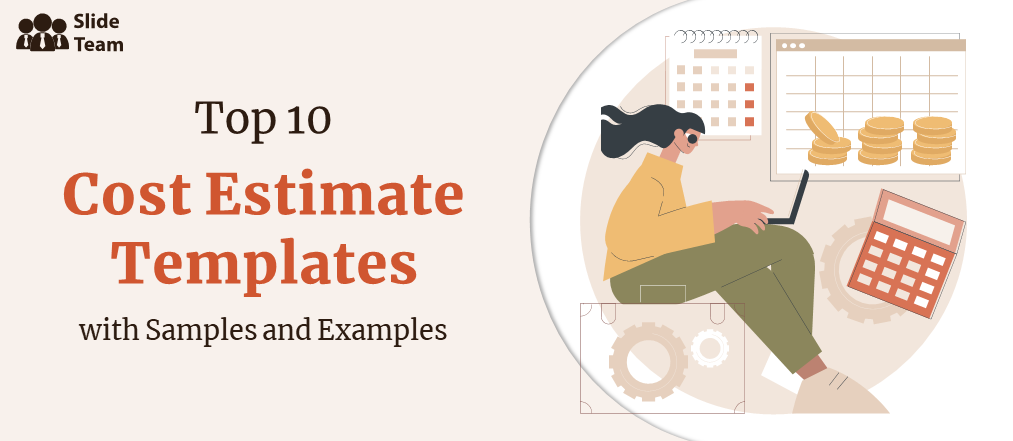
Top 10 Cost Estimate Templates With Samples and Examples
Top 14 pharmaceutical product development templates to document the discovery of effective drugs.
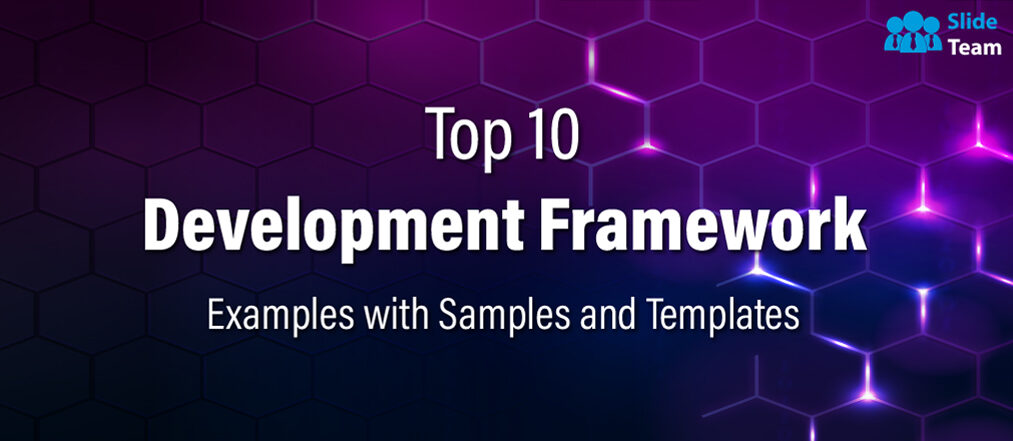
Top 10 Development Framework Examples With Samples and Templates
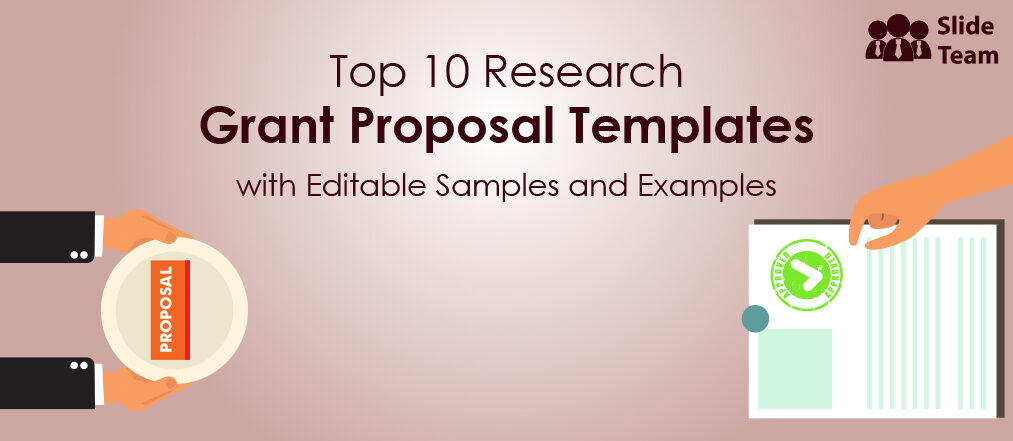
Top 10 Research Grant Proposal Templates With Editable Samples and Examples

Top 7 Roadmap Templates With Samples and Examples
This form is protected by reCAPTCHA - the Google Privacy Policy and Terms of Service apply.

--> Digital revolution powerpoint presentation slides

--> Sales funnel results presentation layouts
--> 3d men joinning circular jigsaw puzzles ppt graphics icons

--> Business Strategic Planning Template For Organizations Powerpoint Presentation Slides

--> Future plan powerpoint template slide

--> Project Management Team Powerpoint Presentation Slides

--> Brand marketing powerpoint presentation slides

--> Launching a new service powerpoint presentation with slides go to market

--> Agenda powerpoint slide show

--> Four key metrics donut chart with percentage

--> Engineering and technology ppt inspiration example introduction continuous process improvement

--> Meet our team representing in circular format

Have a language expert improve your writing
Run a free plagiarism check in 10 minutes, generate accurate citations for free.
- Knowledge Base
- Starting the research process
- 10 Research Question Examples to Guide Your Research Project
10 Research Question Examples to Guide your Research Project
Published on October 30, 2022 by Shona McCombes . Revised on October 19, 2023.
The research question is one of the most important parts of your research paper , thesis or dissertation . It’s important to spend some time assessing and refining your question before you get started.
The exact form of your question will depend on a few things, such as the length of your project, the type of research you’re conducting, the topic , and the research problem . However, all research questions should be focused, specific, and relevant to a timely social or scholarly issue.
Once you’ve read our guide on how to write a research question , you can use these examples to craft your own.
| Research question | Explanation |
|---|---|
| The first question is not enough. The second question is more , using . | |
| Starting with “why” often means that your question is not enough: there are too many possible answers. By targeting just one aspect of the problem, the second question offers a clear path for research. | |
| The first question is too broad and subjective: there’s no clear criteria for what counts as “better.” The second question is much more . It uses clearly defined terms and narrows its focus to a specific population. | |
| It is generally not for academic research to answer broad normative questions. The second question is more specific, aiming to gain an understanding of possible solutions in order to make informed recommendations. | |
| The first question is too simple: it can be answered with a simple yes or no. The second question is , requiring in-depth investigation and the development of an original argument. | |
| The first question is too broad and not very . The second question identifies an underexplored aspect of the topic that requires investigation of various to answer. | |
| The first question is not enough: it tries to address two different (the quality of sexual health services and LGBT support services). Even though the two issues are related, it’s not clear how the research will bring them together. The second integrates the two problems into one focused, specific question. | |
| The first question is too simple, asking for a straightforward fact that can be easily found online. The second is a more question that requires and detailed discussion to answer. | |
| ? dealt with the theme of racism through casting, staging, and allusion to contemporary events? | The first question is not — it would be very difficult to contribute anything new. The second question takes a specific angle to make an original argument, and has more relevance to current social concerns and debates. |
| The first question asks for a ready-made solution, and is not . The second question is a clearer comparative question, but note that it may not be practically . For a smaller research project or thesis, it could be narrowed down further to focus on the effectiveness of drunk driving laws in just one or two countries. |
Note that the design of your research question can depend on what method you are pursuing. Here are a few options for qualitative, quantitative, and statistical research questions.
| Type of research | Example question |
|---|---|
| Qualitative research question | |
| Quantitative research question | |
| Statistical research question |
Other interesting articles
If you want to know more about the research process , methodology , research bias , or statistics , make sure to check out some of our other articles with explanations and examples.
Methodology
- Sampling methods
- Simple random sampling
- Stratified sampling
- Cluster sampling
- Likert scales
- Reproducibility
Statistics
- Null hypothesis
- Statistical power
- Probability distribution
- Effect size
- Poisson distribution
Research bias
- Optimism bias
- Cognitive bias
- Implicit bias
- Hawthorne effect
- Anchoring bias
- Explicit bias
Cite this Scribbr article
If you want to cite this source, you can copy and paste the citation or click the “Cite this Scribbr article” button to automatically add the citation to our free Citation Generator.
McCombes, S. (2023, October 19). 10 Research Question Examples to Guide your Research Project. Scribbr. Retrieved July 1, 2024, from https://www.scribbr.com/research-process/research-question-examples/
Is this article helpful?
Shona McCombes
Other students also liked, writing strong research questions | criteria & examples, how to choose a dissertation topic | 8 steps to follow, evaluating sources | methods & examples, what is your plagiarism score.
The Library Is Open
The Wallace building is now open to the public. More information on services available.
- RIT Libraries
- Social/Behavioral Sciences Research Guide
- Writing a Research Proposal
This InfoGuide assists students starting their research proposal and literature review.
- Introduction
- Research Process
- Types of Research Methodology
- Data Collection Methods
- Anatomy of a Scholarly Article
- Finding a topic
- Identifying a Research Problem
- Problem Statement
- Research Question
- Research Design
- Search Strategies
- Psychology Database Limiters
- Literature Review Search
- Annotated Bibliography
- Writing a Literature Review
Writing a Rsearch Proposal
A research proposal describes what you will investigate, why it’s important, and how you will conduct your research. Your paper should include the topic, research question and hypothesis, methods, predictions, and results (if not actual, then projected).
Research Proposal Aims
The format of a research proposal varies between fields, but most proposals will contain at least these elements: Literature review
Reference list While the sections may vary, the overall objective is always the same. A research proposal serves as a blueprint and guide for your research plan, helping you get organized and feel confident in the path forward you choose to take. Proposal FormatThe proposal will usually have a title page that includes:
Introduction The first part of your proposal is the initial pitch for your project. Make sure it succinctly explains what you want to do and why.. Your introduction should:
As you get started, it’s important to demonstrate that you’re familiar with the most important research on your topic. A strong literature review shows your reader that your project has a solid foundation in existing knowledge or theory. It also shows that you’re not simply repeating what other people have done or said, but rather using existing research as a jumping-off point for your own. In this section, share exactly how your project will contribute to ongoing conversations in the field by:
Research design and methods Following the literature review, restate your main objectives . This brings the focus back to your project. Next, your research design or methodology section will describe your overall approach, and the practical steps you will take to answer your research questions. Write up your projected, if not actual, results. Contribution to knowledge To finish your proposal on a strong note, explore the potential implications of your research for your field. Emphasize again what you aim to contribute and why it matters. For example, your results might have implications for:
Lastly, your research proposal must include correct citations for every source you have used, compiled in a reference list . To create citations quickly and easily, you can use free APA citation generators like BibGuru. Databases have a citation button you can click on to see your citation. Sometimes you have to re-format it as the citations may have mistakes.
Edit this Guide Log into Dashboard Use of RIT resources is reserved for current RIT students, faculty and staff for academic and teaching purposes only. Please contact your librarian with any questions. Help is Available Email a LibrarianA librarian is available by e-mail at [email protected] Meet with a LibrarianCall reference desk voicemail. A librarian is available by phone at (585) 475-2563 or on Skype at llll Or, call (585) 475-2563 to leave a voicemail with the reference desk during normal business hours . Chat with a LibrarianSocial/behavioral sciences research guide infoguide url. https://infoguides.rit.edu/researchguide Use the box below to email yourself a link to this guideOrganizing Your Social Sciences Research Paper: Writing a Research Proposal
The goal of a research proposal is to present and justify the need to study a research problem and to present the practical ways in which the proposed study should be conducted. The design elements and procedures for conducting the research are governed by standards within the predominant discipline in which the problem resides, so guidelines for research proposals are more exacting and less formal than a general project proposal. Research proposals contain extensive literature reviews. They must provide persuasive evidence that a need exists for the proposed study. In addition to providing a rationale, a proposal describes detailed methodology for conducting the research consistent with requirements of the professional or academic field and a statement on anticipated outcomes and/or benefits derived from the study's completion. Krathwohl, David R. How to Prepare a Dissertation Proposal: Suggestions for Students in Education and the Social and Behavioral Sciences . Syracuse, NY: Syracuse University Press, 2005. How to Approach Writing a Research ProposalYour professor may assign the task of writing a research proposal for the following reasons:
A proposal should contain all the key elements involved in designing a completed research study, with sufficient information that allows readers to assess the validity and usefulness of your proposed study. The only elements missing from a research proposal are the findings of the study and your analysis of those results. Finally, an effective proposal is judged on the quality of your writing and, therefore, it is important that your writing is coherent, clear, and compelling. Regardless of the research problem you are investigating and the methodology you choose, all research proposals must address the following questions:
Common Mistakes to Avoid
Procter, Margaret. The Academic Proposal . The Lab Report. University College Writing Centre. University of Toronto; Sanford, Keith. Information for Students: Writing a Research Proposal . Baylor University; Wong, Paul T. P. How to Write a Research Proposal . International Network on Personal Meaning. Trinity Western University; Writing Academic Proposals: Conferences, Articles, and Books . The Writing Lab and The OWL. Purdue University; Writing a Research Proposal . University Library. University of Illinois at Urbana-Champaign. The European Green Deal
 Striving to be the first climate-neutral continent Climate change and environmental degradation are an existential threat to Europe and the world. To overcome these challenges, the European Green Deal will transform the EU into a modern, resource-efficient and competitive economy, ensuring:
The European Green Deal is also our lifeline out of the COVID-19 pandemic. One third of the €1.8 trillion investments from the NextGenerationEU Recovery Plan, and the EU’s seven-year budget will finance the European Green Deal. The European Commission has adopted a set of proposals to make the EU's climate, energy, transport and taxation policies fit for reducing net greenhouse gas emissions by at least 55% by 2030 , compared to 1990 levels. More information on Delivering the European Green Deal . Discover the European Green Deal visual story 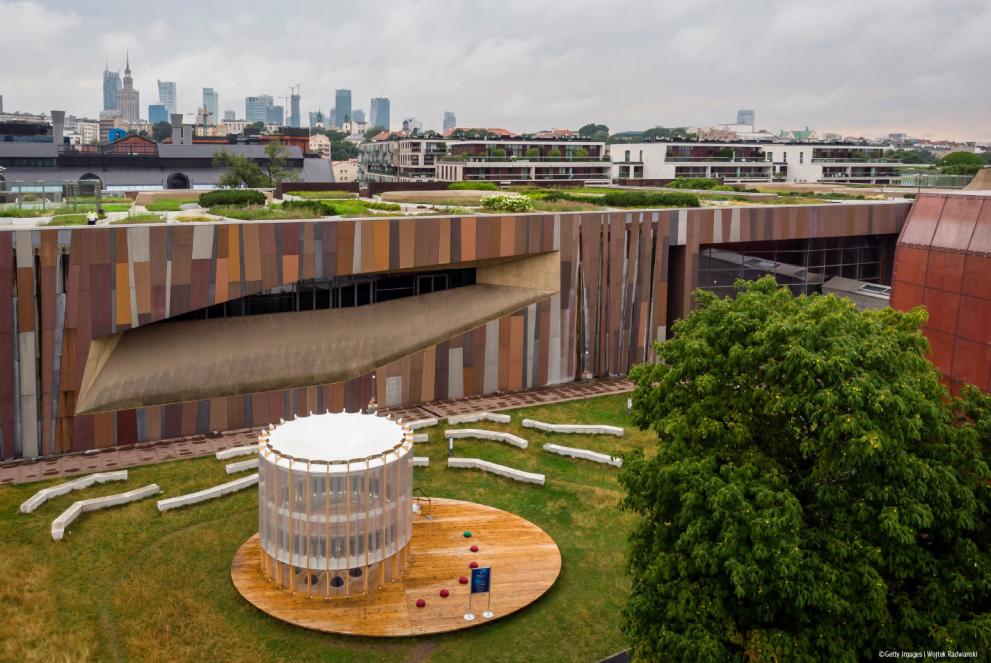 12 March 2024 - The Commission has published a Communication on managing climate risks in Europe that sets out how the EU and its countries can implement policies that save lives, cut costs, and protect prosperity. It comes as a direct response to the first-ever European Climate Risk Assessment by the European Environment Agency. It also addresses the concerns that many Europeans have following last’s year record temperatures and extreme weather events. The Commission is calling for action from all levels of government, the private sector and civil society to improve governance and tools for climate risk owners, manage risks across sectors and set the right preconditions to finance climate resilience. Key figuresFeatured initiatives.  Related linksShare this page  |
IMAGES
VIDEO
COMMENTS
Here are real-life research proposal examples of funded research projects in the field of science and technology. Funder. Title. US Geological Survey (USGS) (Mendenhall Postdoctoral Research Fellowship) Using Integrated Population Modelling in Decision-support Tools to Connect Science and Decision Makers.
Postulate a clear, concise and descriptive title. 1. Abstract. A 250 to 300 words small summary of the proposal. Half page. Section 1: Introduction. Introduce your research topic, give a thorough background and reason to choose the present topic. 1.5. Review of literature.
Abstract: This is a brief (300-500 words) summary that includes the research question, your rationale for the study, and any applicable hypothesis. You should also include a brief description of your methodology, including procedures, samples, instruments, etc. Introduction: The opening paragraph of your research proposal is, perhaps, the most ...
Research proposal examples. Writing a research proposal can be quite challenging, but a good starting point could be to look at some examples. We've included a few for you below. Example research proposal #1: "A Conceptual Framework for Scheduling Constraint Management".
Science posters: advice & samples; Biology honors theses: advice & samples; Science-proposals-grants. Sample student biology research proposal (P. Pazos & P. Hirsch 2008) Grant / proposal writing; What committees look for in evaluating a proposal; Useful web links: citation and style advice from journals, etc. Style-advice-science-writing
This is where you will want to work with your mentor to craft the experimental portion of your proposal. Propose two original specific aims to test your hypothesis. Don't propose more than two aims-you will NOT have enough time to do more. In the example presented, Specific Aim 1 might be "To determine the oncogenic potential of Brca1 null ...
Thesis Proposal Guidelines 1 Thesis Proposal Guidelines Due: Wednesday, July 12 2017 at 3pm (Firm deadline - no extensions!) Prepare a succinct proposal (typically 6-8 double-spaced pages, 1" margins, 12 pt font) concisely describing your proposed project, why it is important, and what you hope to learn from it. Avoid
Proposal Writing Tips. FELLOWSHIP PROPOSALS. Ideally you should have confirmed a lab position far enough ahead (end of Fall term-January) of the summer fellowship deadlines to allow time to meet with your principal investigator and lab mentor to discuss a project. This will help enormously as you prepare to write the research proposal for your ...
The purpose of the research proposal (its job, so to speak) is to convince your research supervisor, committee or university that your research is suitable (for the requirements of the degree program) and manageable (given the time and resource constraints you will face). The most important word here is "convince" - in other words, your ...
typical of science examinations, the laboratory notebook, research papers, research proposals, reviews, and writing for the general public. Chapter III focuses on a key aspect of good writing, namely rewriting. Rewriting is often informed 5 A Student's Guide to Writing in the Life Sciences Chapter I
Make sure you can ask the critical what, who, and how questions of your research before you put pen to paper. Your research proposal should include (at least) 5 essential components : Title - provides the first taste of your research, in broad terms. Introduction - explains what you'll be researching in more detail.
A quality example of a research proposal shows one's above-average analytical skills, including the ability to coherently synthesize ideas and integrate lateral and vertical thinking. Communication skills. The proposal also demonstrates your proficiency to communicate your thoughts in concise and precise language.
Research Proposal Examples. Research proposals often extend anywhere between 2,000 and 15,000 words in length. The following snippets are samples designed to briefly demonstrate what might be discussed in each section. 1. Education Studies Research Proposals.
Here is an explanation of each step: 1. Title and Abstract. Choose a concise and descriptive title that reflects the essence of your research. Write an abstract summarizing your research question, objectives, methodology, and expected outcomes. It should provide a brief overview of your proposal. 2.
Research proposals. Your research proposal is a key part of your application. It tells us about the question you want to answer through your research. It is a chance for you to show your knowledge of the subject area and tell us about the methods you want to use. We use your research proposal to match you with a supervisor or team of supervisors.
Research proposal examples. Writing a research proposal can be quite challenging, but a good starting point could be to look at some examples. We've included a few for you below. Example research proposal #1: 'A Conceptual Framework for Scheduling Constraint Management'.
What's Included: Research Proposal Template. Our free dissertation/thesis proposal template covers the core essential ingredients for a strong research proposal. It includes clear explanations of what you need to address in each section, as well as straightforward examples and links to further resources. The research proposal template covers ...
Here's your go-to slide to pitch your proposal to seek investment for a life-science project. Establish the aim of the research you're about to conduct and its scope. ... Template 4: One-Page Science Research Proposal Example Presentation Report . Invite investors to fund your science research program with this concise one-page proposal ...
The first question asks for a ready-made solution, and is not focused or researchable. The second question is a clearer comparative question, but note that it may not be practically feasible. For a smaller research project or thesis, it could be narrowed down further to focus on the effectiveness of drunk driving laws in just one or two countries.
To finish your proposal on a strong note, explore the potential implications of your research for your field. Emphasize again what you aim to contribute and why it matters. For example, your results might have implications for: Improving best practices; Informing policymaking decisions; Strengthening a theory or model
Sample Research Proposals. You will find here two examples of proposals for postgraduate research from the Department of Social Policy and Criminology. They both give good indication of the sorts of things that need to be included. The first, on fathering after divorce or separation, represents first thoughts on the proposed topic, but sets out ...
The goal of a research proposal is to present and justify the need to study a research problem and to present the practical ways in which the proposed study should be conducted. ... research proposals are generally organized the same way throughout most social science disciplines. Proposals vary between ten and twenty-five pages in length ...
The European Commission has adopted a set of proposals to make the EU's climate, energy, transport and taxation policies fit for reducing net greenhouse gas emissions by at least 55% by 2030, compared to 1990 levels. More information on Delivering the European Green Deal. Discover the European Green Deal visual story